Author: rmccaw
J. Ford Elsaesser
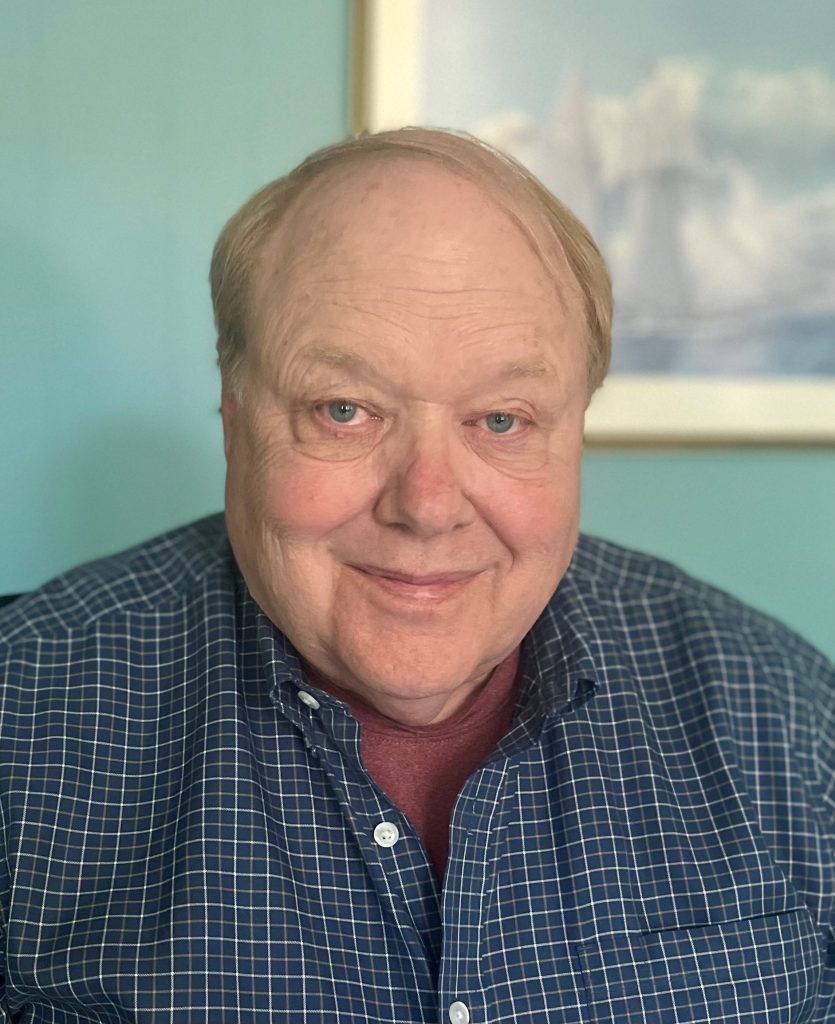
Distinguished Lawyer 2022
Published August 2022
J. Ford Elsaesser, one of Idaho’s most prominent bankruptcy gurus, found himself in a career path committed to helping businesses and individuals alike who are sorting through some of the most difficult financial situations imaginable. Though bankruptcy law was not the original plan, Ford has built a practice he finds fulfilling and one he enjoys, with no plans to retire any time soon.
Ford was born and raised in Youngstown, Ohio, a classic, rustbelt steel mill town on the Pennsylvania border where his family goes back 10 generations and where his ancestors helped develop the steel industry. Ford’s grandfather was from Switzerland, a famous goiter surgeon who worked with the Mayo brothers prior to their founding of the Mayo Clinic, and his father was an established trial lawyer. Ford attended Goddard College in Vermont graduating with his bachelor’s degree.
By then, Ford’s parents were retired and he had met and married his wife, Jean – they will celebrate their 49th wedding anniversary this upcoming October. After his undergraduate work, Ford began working a series of dead-end jobs, everything from running a liquor store, working at a trout hatchery, and working for a used car sales lot. With his family history of professional, career-minded parents and grandparents, Ford had always considered going to law school and was finally ready to act on it. He chose the University of Idaho College of Law in 1974, “because tuition was reasonable and you’d get your residency after a year.” With no connections to Idaho at the time, Ford and Jean drove across the country to Moscow, Idaho with their dog and cat during the summer of 1975.
Ford graduated early in December of 1977 thanks to his dedication to take additional summer classes. With graduation approaching, in the fall of 1977, Ford thought on a whim that he’d ask one of his professors, Tom Cooke, if he would consider hiring an associate to work in their firm, Cooke & Lamanna, out of Priest River. Tom hired Ford before he passed the bar exam and upon his passage and admittance to the Idaho State Bar, Ford began doing general legal work until he later formed his own firm. Together with Steve Verby, Joe Jarzabeck, and one other attorney, they formed what is now Elsaesser Anerson, Chtd. in February of 1980. This is where Ford has remained ever since.
During his time at Cooke & Lamanna, Ford sort of fell into doing bankruptcy work unexpectedly. In 1978, the bankruptcy code was changed. Since Ford was already doing a good portion of the firm’s bankruptcy work out of necessity, his workload increased as he was the one expected to learn the new code. The work became more and more interesting to him and once he made the transition to his own firm, he started working almost exclusively on more complicated bankruptcy matters. In 1984, Ford was appointed as a Chapter 7 Trustee.
Later, he became heavily involved in the American Bankruptcy Institute (“ABI”). He served as chairman (immediate past president) from 2000 to 2001, and President from 1999 to 2000. He was inducted into the American College of Bankruptcy, Sixth Class, in May 1995. He received the Idaho State Bar Professionalism Award in 1999 and Idaho State Bar Pro Bono Award in 1991.
Among some of Ford’s most notable casework, he recalls his first big Chapter 11 case for Riley Creek Lumber, which later became Idaho Forest Group. Working on this in the mid-1980s, Ford was able to save the jobs of not only the people who worked in the mill, but also the jobs of the loggers who supplied the mill. This was a particularly proud moment, coupled also with his work to help the Idaho Alfalfa Seeds Growers obtain financial help through the bankruptcy process and what resulted in the passage of a bipartisan federal bill.
Throughout his career Ford has looked to many of his mentors and colleagues alike to model professionalism, integrity, and diligence of mind. Of these individuals, Ford recalls learning much from his long-time friend, even after law school, Professor James MacDonald. He also notes the inspiration of Tom Cooke and Nick Lamanna, who hired him straight out of law school. Ford mentions the work of bankruptcy judges Merlyn Young and Alfred “Bud” Hagan as being wonderful judges and role models for his career. And perhaps more than anyone, Ford notes such deep admiration for and inspiration from Dean Menard at the University of Idaho College of Law. Ford mentions, “He took the law school to a whole new level.”
When looking back on his distinguished career, Ford notes two things he finds himself most proud of. First, his work in growing the American Bankruptcy Institute. During his time serving on the board, he was responsible for membership for a portion of those years and was able to grow the membership from 3,000 members to over 12,000 members nationwide. And second, he is constantly impressed to see the accomplishments of his former students from his time teaching bankruptcy at the University of Idaho College of Law for the past 20 years. He notes the achievements of Judge Noah Hillen, who is “perhaps the youngest bankruptcy judges in the country,” and of Jason Naess, the current U.S. Trustee in Idaho. Ford mentions the satisfaction of feeling like you’ve “left a little bit of a legacy.”
Outside of his practice and the legal profession, Ford has spent many years serving members of the public and his community. He has served on the school board for Bonner County, serving as chairman for five years. He sits on the board for Bonner General Hospital in Sandpoint, having been chairman for the past 14 years. In 2001, Governor Kempthorne appointed Ford as chair of the Lakes Commission, dedicated to looking after Lake Ponderay and the other bodies of water in North Idaho. Ford has served on the Idaho Humanities Council, the Board for the Idaho Community Foundation, and the University of Idaho College of Law Advisory Board.
Ford and his wife, Jean, have three children: Matt, the eldest, lives in Helena, Montana and owns an electronic recycling and composting business; Heidi is a cancer researcher in Toronto, Ontario, having previously worked at Scripps Hospital and University of California, Los Angeles; and Katie is an attorney practicing in the family firm since graduating from the University of Idaho College of Law in 2013. On the weekends, Ford enjoys hiking with his and his daughter’s dogs, being out on the water in the summer, and skiing in the winter.
Ford would especially like to thank Jean, Matt, Heidi, and Katie for their patience and support; his long-time support staff, Lois (28 years), Naomi (20 years) and Debbie (38 years); and the Bench and Bar of Idaho that has made this a wonderful place to practice and learn over the last 44 years.
T. Matthew Wolfe, Ludwig Shoufler Miller Johnson, LLP
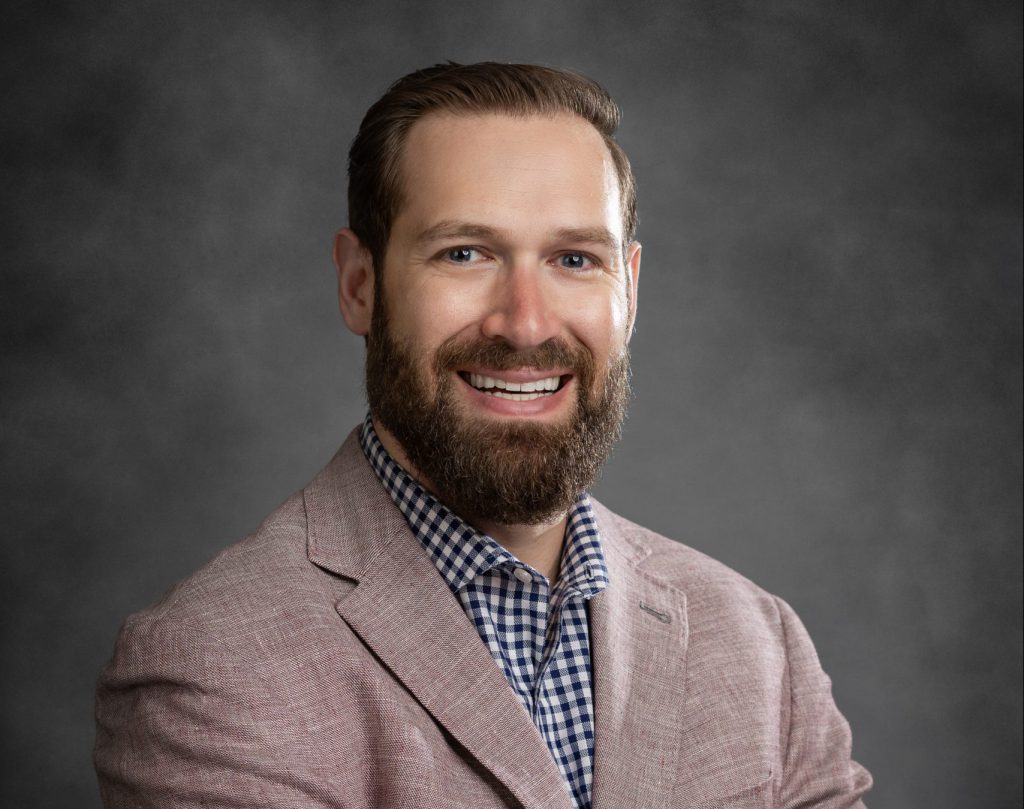
Outstanding Young Lawyer 2021
This year’s Outstanding Young Lawyer, Matt Wolfe, is a Boise transplant and has moved around all over the globe serving our country as part of the National Guard. Matt was born and raised in Hopatcong, New Jersey, a small borough in Sussex County and joined the National Guard straight out of high school. After completing basic training, he was immediately deployed to Guantanamo Bay and recounts this as both a weird and interesting experience for a young 19-year-old kid.
Matt spent the next 10 years working as a contractor for the military, which took him all over the world, including Cuba, Kuwait, Hawaii, and Washington D.C. During this time, he completed his undergraduate education online through the American Military University and began entertaining a change in career trajectory. His goal was to find something a little more stable and conducive to long term career building. Matt felt the legal profession would be a natural fit and a good transition, allowing him to utilize the research, writing, and briefing skills he had honed during his time in military service. He began looking for options on where to attend law school and after stumbling across an article online about Boise, Idaho, decided to relocate from the East Coast to attend Concordia University School of Law. Matt graduated with his law degree from Concordia in 2016 and was admitted to the Idaho State Bar that same year.
After receiving his law degree, Matt and his wife, Ashley, who he met during his second year of law school, moved back to the East Coast where he attended Boston University and received his LL.M. Hoping to begin his career back in Idaho – and avoid having to take the bar exam in another state – Matt began seeking out conversations with Idaho lawyers who had also received their LL.M. degrees. It was through this networking effort that Matt got connected with Tom Walker who offered him a job as an associate in his new Boise firm, Generations Law Group. Matt began working with Tom and remained at Generations Law Group until late last year.

In September 2020, Matt transitioned to the firm Ludwig Schoufler Miller Johnson, LLP where he continues to practice family law, estate planning, and probate. Matt considers both Tom Walker and Scott Ludwig among his professional role models and is grateful for the opportunity to learn from their expertise.
While balancing his workload, Matt is involved in several law related volunteer efforts. Encouraged by Tom Walker to get involved and continue networking, Matt ran for an open position as an officer for the Fourth District Bar Association and is now serving as Vice President. He is also the current CLE Chair of the Idaho State Bar Young Lawyer Section and serves as Chair of the Idaho Military Legal Alliance, a Bar related entity providing free legal services for veterans across the state. The Idaho Military Legal Alliance is currently conducting a monthly, phone clinic for Veteran’s, and Matt would ask that any attorney interested in helping a Veteran to please get in touch with him.
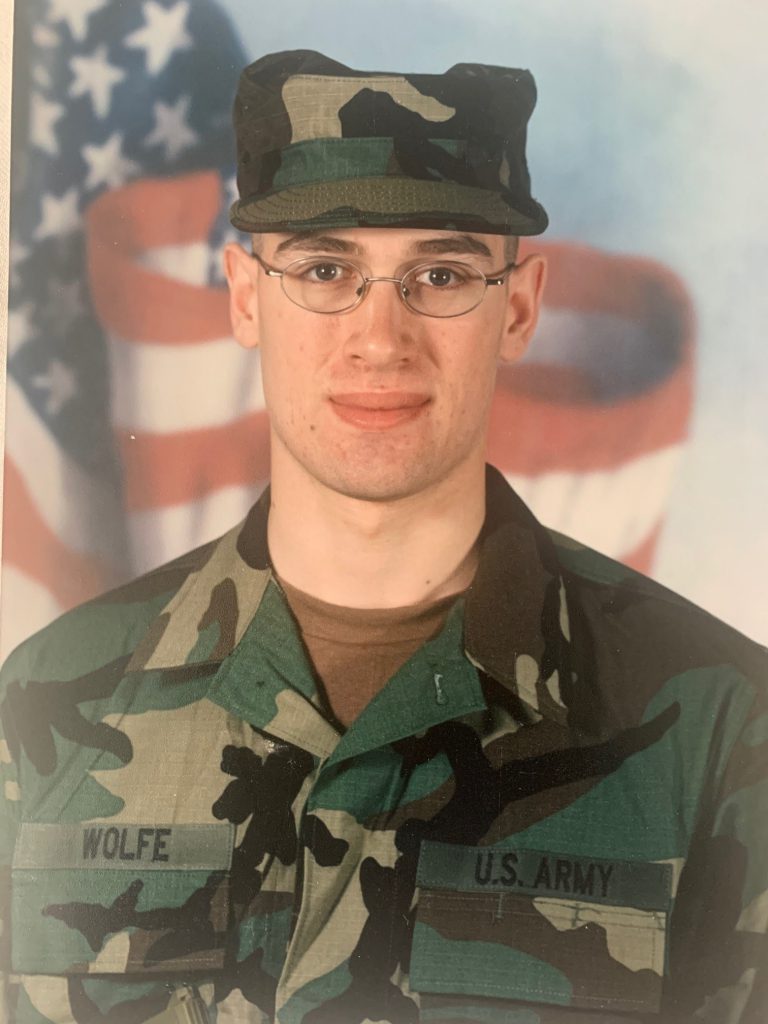
Continuing with this theme of getting involved and contributing to the local Bar community, Matt’s advice to his younger self – and other young lawyers – is to set aside the hesitation to reach out, put yourself out there, or make new connections within the Bar. Matt mentions that Idaho attorneys are fortunate to be part of a Bar that is small enough in which you can easily meet other attorneys in your practice area or from whom you would like to learn. He would also make sure to tell his younger self to buy Bitcoin, buy a lot of Bitcoin.
Matt and his wife, Ashley, have three children – a five-year-old and three-year-old twins. Matt enjoys woodworking, golf, and fantasy football, though he jokingly mentions that he does not have time for much in terms of hobbies with three little ones running around.
Matt notes that the hardest part of being a younger attorney is not having all the answers, even though your clients and judges require you to have all the answers. Clients pick your firm based on the collective experience of the firm, and you do not want to make your client second guess their decision by not having all the answers. However, you need to make sure you are giving you clients the best advice possible, which sometimes requires you to check with the partners of the firm.
The best part of being a younger attorney is getting to learn. You learn something new every day about the legal code, or the bar, or some “unwritten rules” of practicing law. Plus, being a younger attorney sometimes gives you an upper hand in a case since you might look at a problem differently than an attorney that has practicing for a while.
Matt would like to extend his gratitude to some of the many people that have helped him over the years: everyone in his Concordia Family, all the amazing people at the bar, Tom Walker, Scot Ludwig, all support staff (Is there a better way to say that), and he’d like to end by thanking his mom.
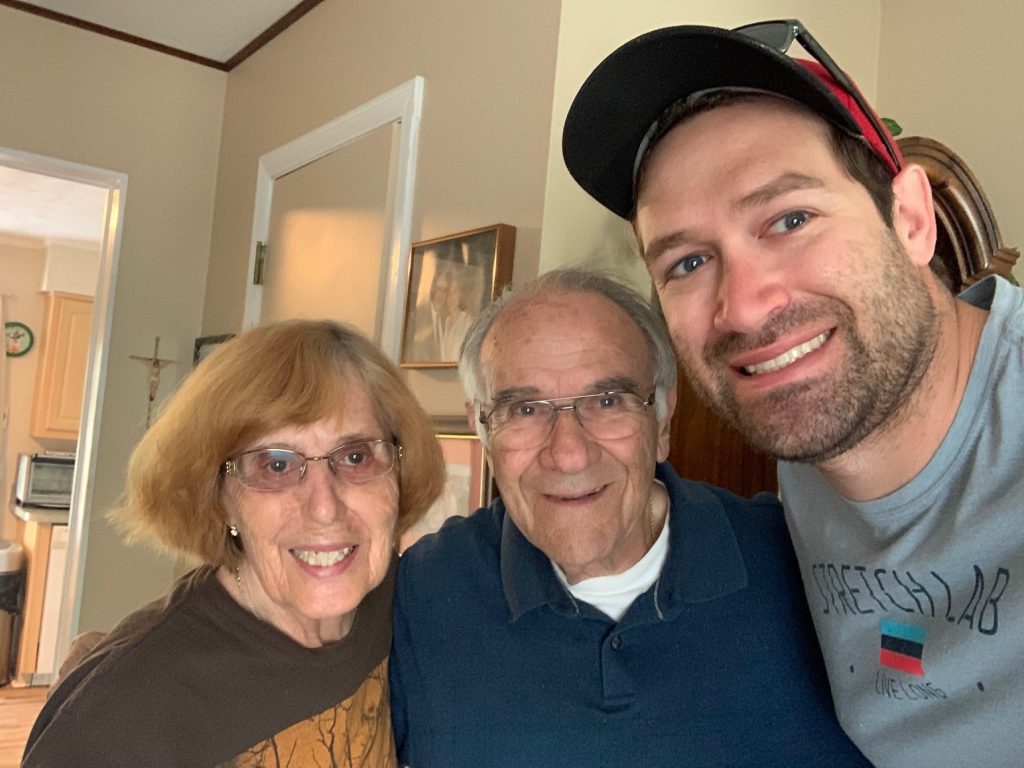
Hon. Deborah A. Bail, Fourth District Court

Distinguished Jurist 2021
Fourth District Judge Deborah Bail boasts a career filled with historic milestones for the legal profession in the State of Idaho. Admitted to the Idaho State Bar in 1975, Judge Bail is one of Idaho’s first 50 women lawyers, later claiming another first with her appointment as Idaho’s first woman District Judge. She has been at the helm of ushering in many marked improvements to the lives of Idaho’s citizens, both early in her legal career and as a member of Idaho’s judiciary.
Considering herself a Midwesterner at heart, Judge Bail was born in Wichita, Kansas where she and her family lived until her early teens. Her father was an engineer, and her mother had a degree in archaeology. Both parents were encouraging of all endeavors, consistently instilling the perception that there was not a single thing women could not – or should not – pursue. It was not until her entrance into college that Judge Bail was met with even the slightest indication that society at the time may have a different point of view.
At the end of Judge Bail’s high school career, her family moved to Hawaii and she attended the University of Hawaii for two years. Judge Bail then transferred to Lewis and Clark College in Portland where she finished her undergraduate education and received her B.A. in History in 1971. Judge Bail recalls always holding on to the assumption that she would have some sort of career and she considered both the medical and legal professions.
To some degree, the law was always in her peripherals, as her family history is steeped with strong ties to the legal profession – female ancestors on her mother’s side of the family had been blazing the trail for women in the law since well before this Nation’s inception. One of her mother’s ancestors, Margaret Brent, was the first woman in the soon-to-be United States to perform legal services, representing the royal governors of both Maryland and Virginia in the 1600s. Another of her mother’s ancestors served as George Washington’s lawyer and spent time as Thomas Jefferson’s law partner. He was a judge who trained many young lawyers. He presided over the Constitutional Convention when Benjamin Franklin was unavailable.
Some may say these early influences set the course for Judge Bail’s later career trajectory indefinitely. What is certain, Judge Bail recalls, is that she was drawn to the practice of law after witnessing the good things lawyers were doing to improve the lives of people nationwide during the dynamic years of the 1960-70s while she was in college.

After her undergraduate education, Judge Bail remained in Portland and attended Northwestern School of Law where she received her Juris Doctorate. She viewed her entry into the legal profession as an opportunity to make real change in the lives of those around her. Immediately after graduating with her J.D. she received the Reginald Heber Smith Fellowship – the first from her law school to do so. This brought her to Idaho where she worked with the Boise office for Idaho Legal Aid Services, Inc. from 1975 until 1977. One of her early practical lessons that was not taught in law school– keep a box of Kleenex at your desk for your clients.
Her time in public service law resulted in another first, the establishment of Emergency Housing Services – the first shelter in Idaho for homeless women and their children, and victims of domestic violence. These new services in Idaho came ahead of the curve of many more densely populated, urban centers around the country. Following the conclusion of her fellowship, Judge Bail began work developing legal services for the elderly in Idaho.
In 1978, Judge Bail transitioned back to her original love of trial work. She handled civil matters and prosecuted federal cases as an Assistant U.S. Attorney for the District of Idaho. She enjoyed this work until 1983, when she was appointed to the District Court bench by Governor John V. Evans. Judge Bail took office on April 18, 1983 as the first woman District Judge in Idaho. During her tenure on the bench, she has served as a pro tem on both the Idaho Supreme Court and Idaho Court of Appeals. Hearkening back to her love of public service law, she continues to lead efforts to reduce costs in district court cases while improving public access to the court system for Idaho’s citizens.
Judge Bail points to two notable moments in her career as being those of personal importance. First, her work on Idaho Schools for Equal Educational Opportunity v. State of Idaho from 1990 to 2005 left a marked impression on how she views her role as a judge. Throughout the course of this case, Judge Bail notes the incredible responsibility that comes with issuing a decision that holds such far-reaching implications. In this case, Judge Bail mentions coming to terms with the possible ramifications of doing what she deemed to be the right thing, despite the possible unpopular opinion to the contrary. The Idaho Supreme Court’s decision to uphold her judgment that Idaho’s system for funding school construction projects was unconstitutional was a welcomed one.
Second on the list of rewarding career moments is the beginning of Judge Bail’s responsibilities as a treatment court judge in 2017. In addition to maintaining a heavy docket of both criminal and civil cases, Judge Bail is responsible for Ada County Drug Court 1, where she works with defendants who are trying to gain control of their addiction and build law-abiding, productive lives that they truly enjoy. Judge Bail has found this time to be incredibly rewarding and notes the importance of utilizing evidence-based practices for this most vulnerable population.

Judge Bail’s service to the community, both legal and otherwise, stretches far and wide. She served as a faculty judge for the University of Virginia College of Trial Advocacy in 2008 and as a presenter at the Osher Institute on Criminal Sentencing in 2011. Her time on several Court committees has included that of the Idaho Civil Rules Committee, Judicial Fairness Committee, Judicial Education Committee, Criminal Jury Instructions Committee, and the Gender Fairness Task Force. She served as the Chair of the Idaho Law Foundation’s Law Related Education Committee, as both past president and officer of the Idaho District Judges’ Association, has volunteered with the Idaho Mock Trial program, and was a speaker for the Citizens’ Law Academy on sentencing. She enjoys interacting with children and adults and introducing them to the legal system.
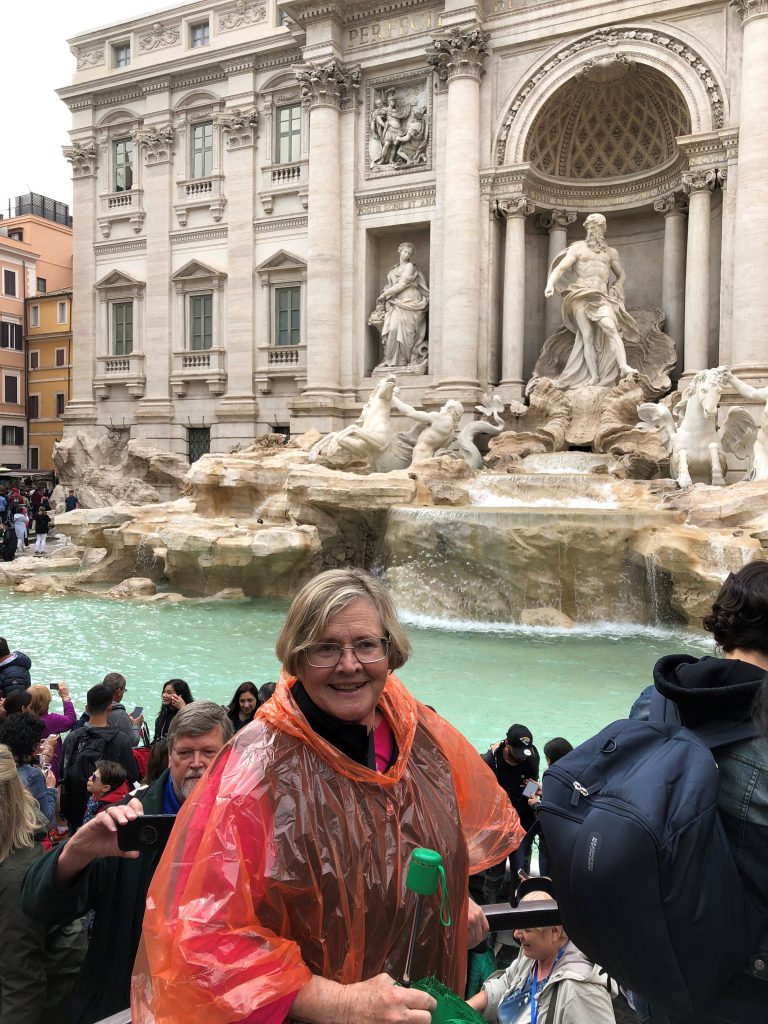
Judge Bail has also served on the Board of Directors for the Presiding Bishop’s Fund for World Relief, the Board of Trustees for the Church Divinity School of the Pacific, and the Board of the Rotary Club of Boise – also being one of the first women members. She is a former member of the St. Luke’s CARES Advisory Board and served on the Board of Directors for the Small Village Foundation, a Boise-based foundation sponsoring adult and youth service trips to South Africa to work with underprivileged populations in the Zulu heartland.
Judge Bail has a daughter who she adopted from India as a young toddler; Basanti considers herself an Idaho native and works at Micron Technology. Together they have worked on various projects that address homelessness in Boise. Judge Bail is an avid traveler, loves golfing and mystery novels.
After decades of committed service to the people of Idaho and abroad, Judge Bail is preparing for a short sabbatical before taking status as a Senior Judge – a title she intends to change to “Special Ops Judge,” since she lightheartedly says the nature of the work is specifically for “us highly trained operatives who just go in for targeted cases.”
Judge Bail would like to extend her gratitude to her family, wonderful staff, the talented and skilled drug team, colleagues past and present and the many fine members of the Idaho state bar that she has had the opportunity to work with.
Debora Kristensen Grasham, Givens Pursley LLP
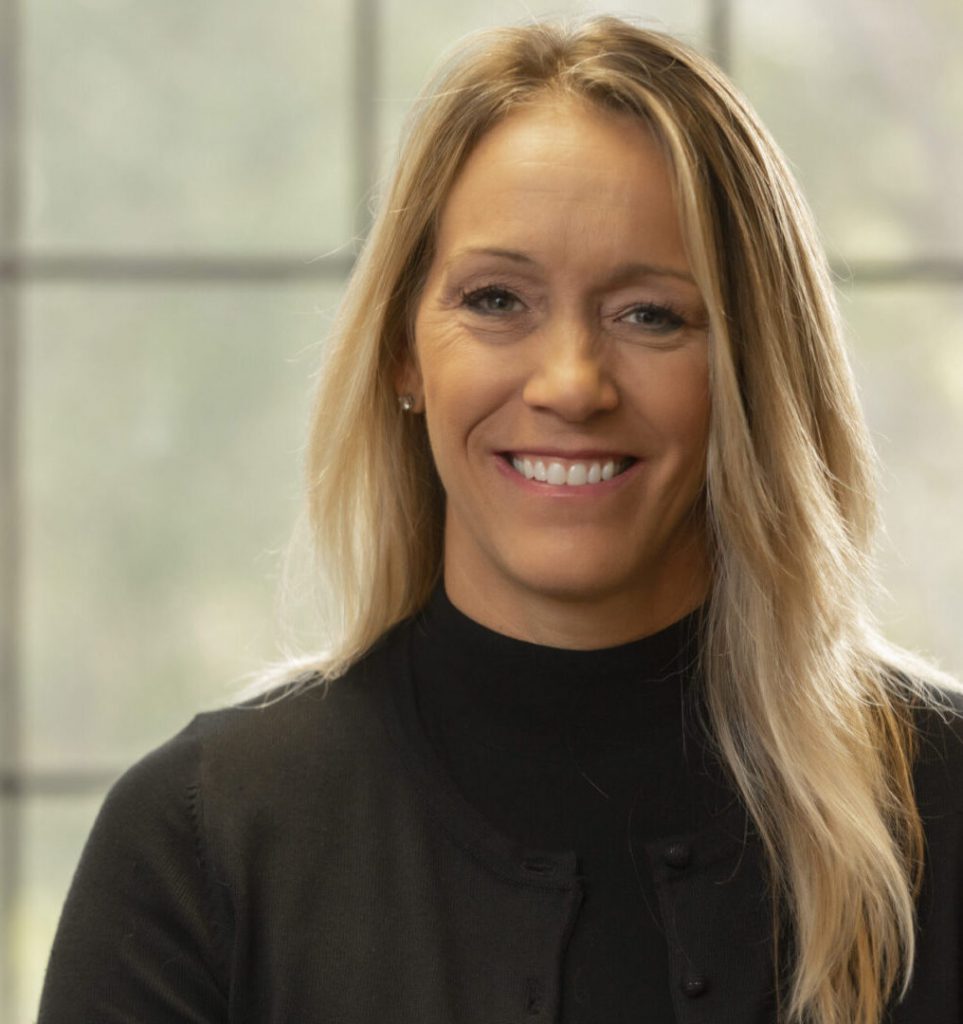
Distinguished Lawyer 2021
The oldest of three girls, Debora (Deb) Kristensen Grasham was born outside Pittsburg, Pennsylvania. Her father worked as an engineer, and his job took the family from Pennsylvania to Wisconsin, then finally California. Eventually, her father decided to pursue a new career in law and Deb recalls her father putting in long days at work only to continue his day with a commute into San Francisco to attend law school at night. Deb also recalls the patience and strength of her mother in supporting her father during this time, while raising three girls. Deb grew up in the San Francisco Bay Area from her kindergarten years and jokes that anyone who knows her would categorize her as a Californian.
All throughout high school Deb played just about every sport and carried that athleticism into her collegiate career, playing volleyball at the University of California Berkeley. Deb initially attended U.C. Berkeley with the intention of going to medical school and becoming a doctor – she recalls, however, a change in perspective after someone stole her lab book for her organic chemistry class. If those around her were already that cutthroat, she was not certain the medical profession was going to be a good fit for her.
Deb changed course, received her B.A. in Psychology, took the LSAT her senior year, and, remembering the hard work of her father, started down the path toward law school. She attended Santa Clara University School of Law, where she was Editor in Chief of the Law Review receiving her law degree in 1990. Immediately after graduation she accepted a job in San Francisco and had planned to remain a Bay Area kid but having also met and fallen in love with her first husband who was in medical school at UCLA, another course change was right around the corner.
Together in 1990, Deb and her then-husband moved to Seattle for his orthopedic surgery residency where they would stay for the next five and a half years. Deb recalls being fortunate enough to have an interview with the law firm of Davis Wright Tremaine as soon as she arrived in Seattle – she was offered the job same-day and accepted. Thus began her career in the law with her time in Seattle serving as the starting-off point for the next several decades of what would become a markedly impressive commercial litigation practice.
Her first assignment as she walked through the door of her new office was in media law with instructions to draft a petition for certiorari to the United States Supreme Court on behalf of the firm’s high-profile client, CNN. At the time, CNN had been barred by a federal district court in Florida from broadcasting the contents of recordings of Manuel Noriega, the former Dictator of Panama, with his defense team that had been taped by the government while Noriega was in a Miami jail. In just a few short weeks, the case escalated from the district court to the U.S. Supreme Court. See Cable News Network, Inc. v. Noriega, 498 U.S. 976 (1990). Deb remembers this as an early career highlight, having excitedly called her parents to tell them to turn on the news and see what she was working on in her new job.
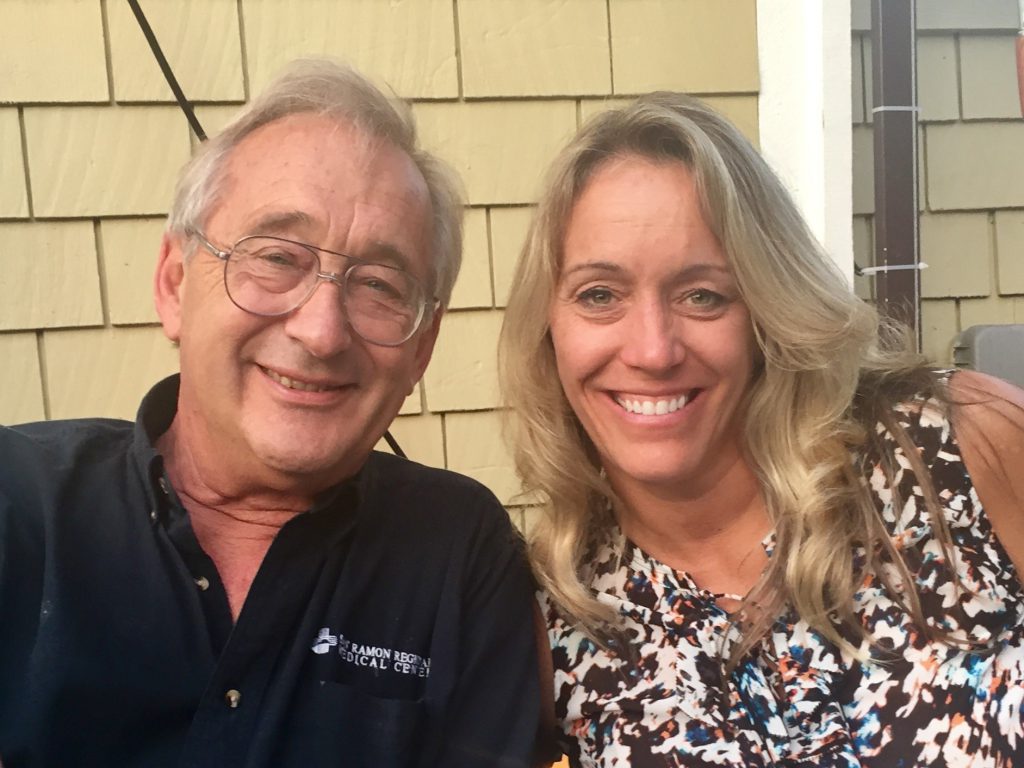
A few years later in 1996, Deb transferred to her firm’s Boise office to relocate for the start of her husband’s career and a family. They had their first son, Drew, that same year, followed by their second son, Trent, in 1999. Around this time, Davis Wright Tremaine was winding down its Boise office and Deb began looking to work elsewhere. She went to work in the commercial litigation practice at Givens Pursley LLP in 1999 and has happily been there ever since. In addition to her varied litigation practice, Deb has maintained her passion for media law and represents most of the local Boise media outlets and national entities who find themselves involved in legal disputes for access or litigation
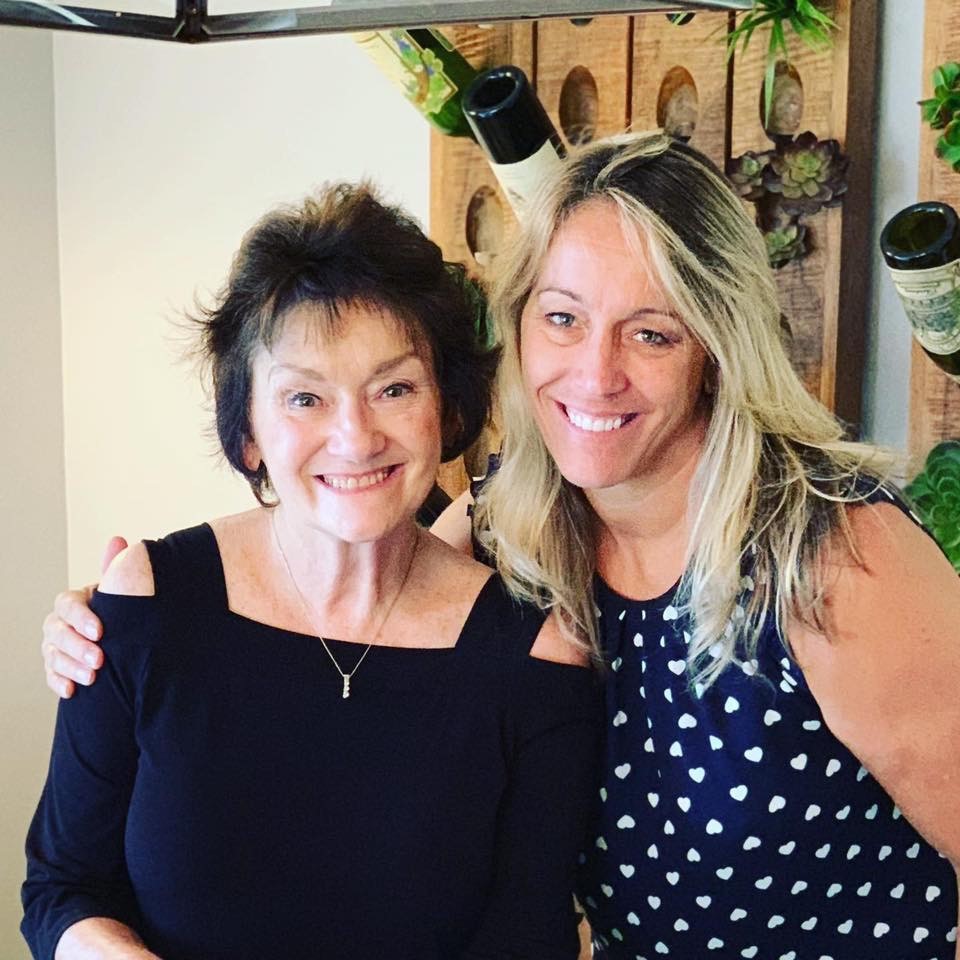
After her move to Givens Pursley, Deb and her first husband divorced in 2002. Now a working, single mom with a five and two-year-old, Deb recounts her gratitude to her new colleagues, crediting the partners at the time for their understanding, support, and encouragement. Deb did not have the luxury of staying home with her boys, and instead recommitted to her practice and engagement with the bar.

In 2002, Deb was elected to represent the Fourth District as only the third woman to serve on the Idaho State Bar Board of Commissioners – later also serving as Idaho State Bar Commission President during her term from 2002 to 2005. Deb mentions that her time on the Board was another career highlight, as she felt a sense of pride to be part of the Idaho State Bar’s history and truly enjoyed traveling across the state to meet fellow Idaho lawyers from all walks of life. It was also during this time that Deb took note of something that she would make it her goal to change. During the first Annual Meeting that Deb attended as an ISB Commissioner, she noticed that all the past recipients of the bar’s highest honor, the Distinguished Lawyer Award, were men. Deb was disappointed to not see a single woman and was determined to change this. Thus, the very next year in 2003, she successfully nominated long-time Rexburg attorney Mary Smith Oldham – the 10th woman admitted to practice law in Idaho — to become the first woman to receive the Distinguished Lawyer award. Since then, Deb proudly notes, the Idaho State Bar has recognized several other outstanding women with this award for their achievements – making her selection this year even more meaningful and special.
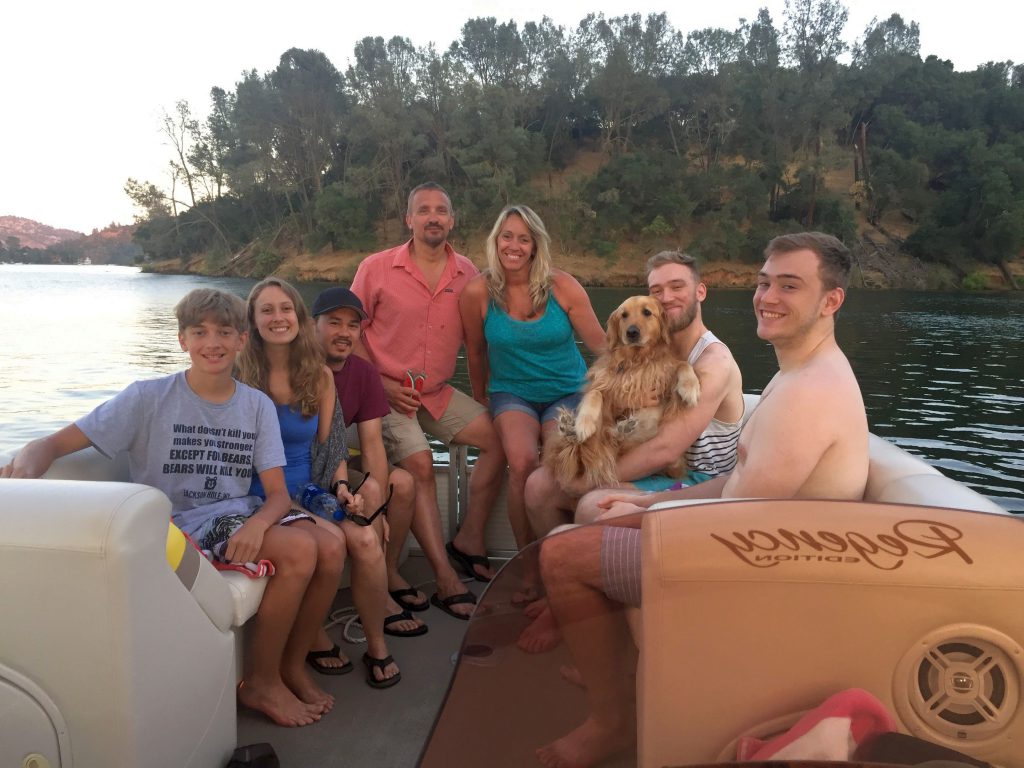
Deb notes that her main role models, first and foremost, have always been her mother and father, Bob, and Kathy Dimino. Both personally and professionally in every way, Deb looked to them for guidance and learned from them that family is always first. She was taught by her parents that for all the things that seem to matter in a career, people – and family in particular — are what are the most important.
Deb also mentions if she had to pick a single professional role model other than her parents, she would attribute much of what she learned early on to the late Cam DeVore during her time at Davis Wright. Cam took Deb under his wing and made it his mission to get her meaningfully involved in what was, at that time, a man’s world, and a heavily male-dominated profession. Deb described Cam as a brilliant, nationally known First Amendment lawyer who never took himself too seriously and always made others feel valued. He taught her that the practice of law is tough, but a worthwhile and nobel profession and to remember that lawyers are so much more than just people who show up in court for their clients.
Over the course of more than 30 years, Deb has been fortunate to represents clients, both big and small, in a variety of industries and areas. From the Seattle Seahawk’s Brian Bosworth, triple crown winner Seattle Slew, national media entities USA Today, CBS and TNT, to the Idaho Dairymen’s Association, Union Pacific Railroad, and numerous local media entities including KTVB, The Idaho Statesman, Adams Publishing, and the Idaho State Broadcasters Association. This varied clientele has allowed Deb to build relationships throughout the state and region, and work in exciting areas of law in both state and federal court.
While Deb has served on several community and bar related boards and committees, her dedication to and fascination with the legal profession has been a special area of interest. A self-proclaimed history buff, Deb has taken on countless history-related projects over the years. In 2005, she worked on and published the First 50 Women in Idaho Law project for the Idaho State Bar, in which she compiled an expanse of research detailing the lives of the first 50 women to be licensed to practice law in Idaho. Deb considers it a special responsibility to collect, capture, and preserve these stories so that they are not lost with the passage of time
In this same vein, Deb has been very involved in the Idaho Legal History Society, having served as its President from 2008 to 2010. More recently, she has also been a member of the Board of Directors for the Ninth Judicial Circuit Historical Society, and currently serves as its Chair (the first Idahoan to hold such position). Deb brought her interest in women’s legal history to the Society by highlighting the first woman to practice law in each of the Ninth Circuit jurisdictions via the Society’s webpage and social media platforms. She also recently assisted the Idaho State Historical Museum with their exhibit on Trailblazing Women in Idaho and a similar exhibit planned to be displayed at the Idaho Capitol building.
Deb married Charlie Grasham three years ago, whom she credits with much patience and support as she pursues her many interests and busy practice. They live in Boise with their golden retriever Spud. Deb would like to extend her sincere thanks and gratitude to her family, friends, and colleagues at Givens Pursley and throughout the bar for their support over the years. She notes that she is “not dead yet” and plans to be around for many years to come.
Recap of the 2021 Idaho State Bar Annual Meeting
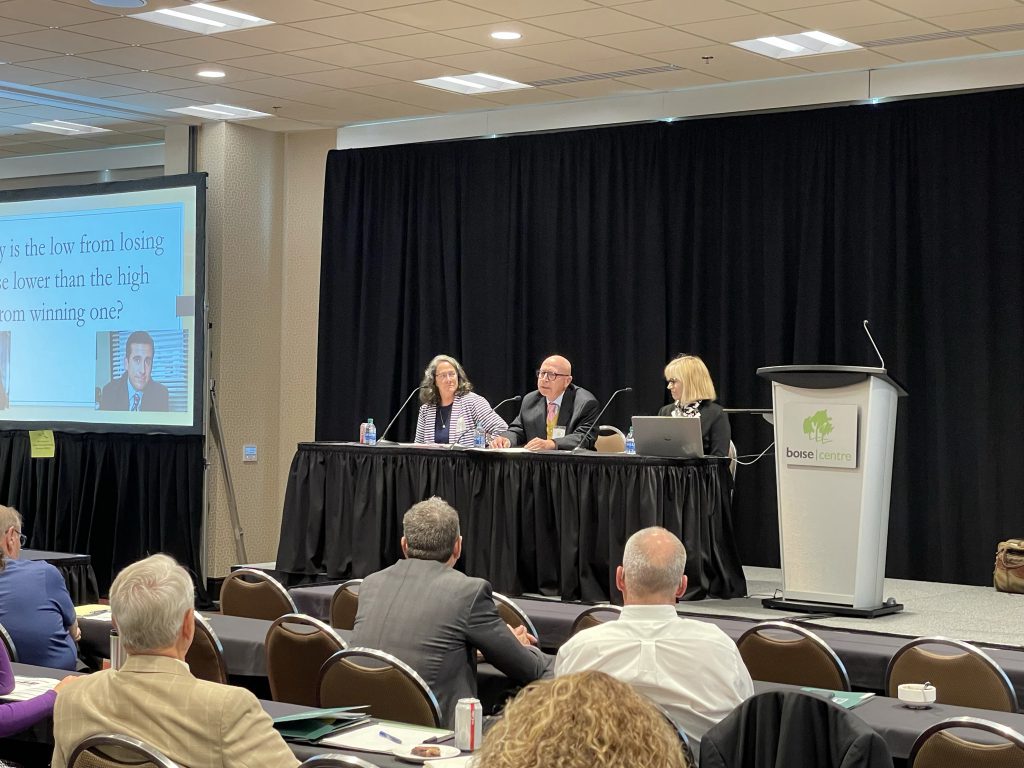
Teresa A. Baker
Published September 2021
The 2021 Idaho State Bar Annual Meeting was held at Boise Centre East on July 21st through the 23rd. Due to the continuing concerns regarding the COVID-19 pandemic, the meeting was offered as a hybrid event with both in-person attendance and a webcast option. All three of the award events were also livestreamed via YouTube. Each of the award events are available to watch on the Idaho State Bar YouTube channel.
The Distinguished Lawyer & Jurist Awards Reception was held on Wednesday evening, July 21st, at the Riverside Hotel with President Donald F. Carey serving as the Master of Ceremonies. The recipients of the 2021 Distinguished Lawyer Awards were Howard A. Belodoff of Boise, Debora Kristensen Grasham of Boise, and Donald J. Chisholm of Burley. The Distinguished Jurist Award was presented to Judge Deborah A. Bail, retiring Fourth District Judge. The Outstanding Young Lawyer Award was presented to T. Matthew Wolfe II of Boise. Each award recipient was introduced with a short, recorded video in which they were interviewed by a colleague or friend and then each graciously accepted their award at the podium. In addition to members of the bar and family and friends of the honorees, there were over 20 students from the University of Idaho College of Law in attendance.
Thursday morning, July 22nd, began with a Plenary Session in which Idaho Supreme Court Chief Justice G. Richard Bevan gave an update on the state of the Idaho courts. President Carey then introduced the new Dean of the University of Idaho College of Law, Johanna Kalb, who gave a few remarks. Incoming Commissioner Gary L. Cooper introduced the keynote speaker, Walter Echo-Hawk. Mr. Echo-Hawk is an attorney, author, former Tribal Judge, and President of the Pawnee Business Echo-Hawk Council for the Pawnee Nation of Oklahoma. He spoke on the topic of the human rights era in Federal Indian law. This session and CLE was offered at no cost to members of the bar and 144 members attended via webcast. A total of 6.0 CLE credits were offered on Thursday with breakout sessions offered twice. The late afternoon CLE session featured the annual “Lessons from the Masters” program. The presenters for this year’s installment were Trudy H. Fouser and Wendy J. Olson, both of Boise, and Tim Gresback of Moscow.
During a noon luncheon, the Idaho State Bar and Idaho Law Foundation Service Awards were presented. Eleven lawyers from around the Gem State who have provided volunteer time to support the work of the Bar and the Law Foundation were honored. The Section of the Year Award was also presented to the members of the Child Protection Section. When the awards program concluded the Idaho Law Foundation held their Annual Meeting led by President Kari M. Campos of Idaho Falls.
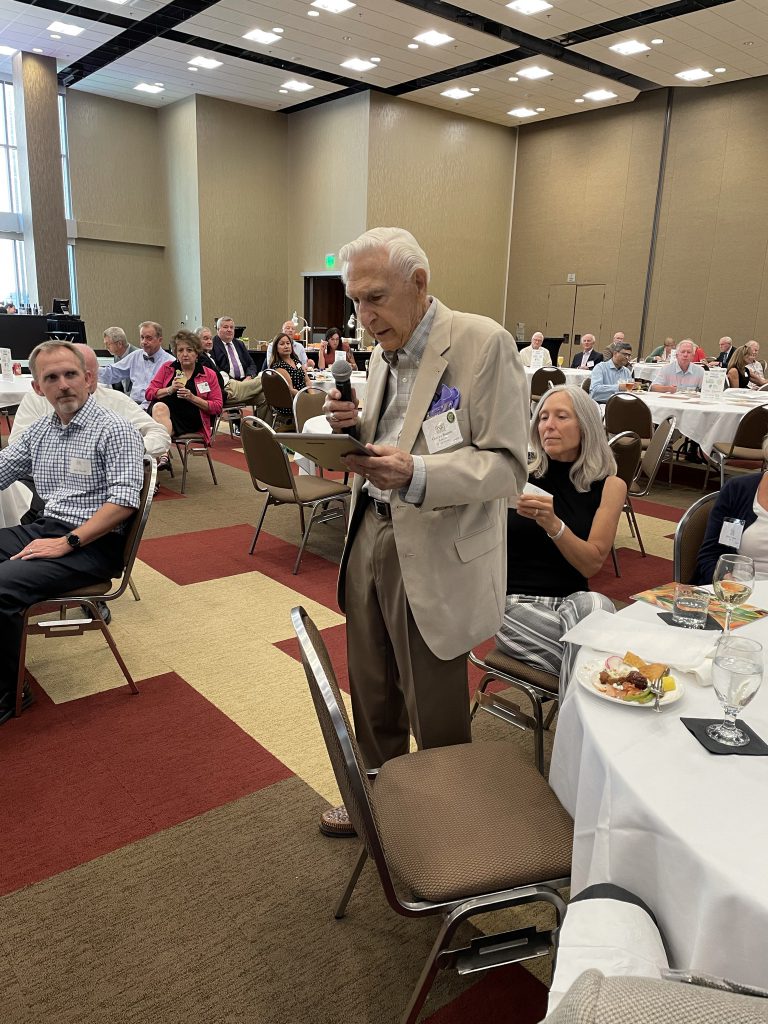

The Milestone Celebration and Awards Reception: Celebrating 25, 40, 50, 60, 65 & 70 Years of Admission was held Thursday evening with over 100 people in attendance. James Charles “Chuck” Blanton was honored as the sole 70-year member, and he spoke about his years of practice that started in 1951. Other awards presented during the evening included The Advocate Awards and the new Idaho Legal History Section presented the Byron J. Johnson Award to the Honorable B. Lynn Winmill, U.S. District Court Judge and the Honorable Ronald E. Bush, U.S. Magistrate Court Judge.
On Friday, July 23rd, an additional 5.0 CLE credits were offered to conference participants. The late afternoon session featured the flagship CLE entitled “The Climate of Civility and Professionalism in the Practice of Law in Idaho.” The CLE was sponsored by the Professionalism and Ethics Section and the presenters discussed the 2020 Climate of the Legal Profession in Idaho survey and suggested ways to improve inclusivity for all members of the bar, clients, and community. The Annual Meeting officially adjourned at 2:45 p.m. on Friday afternoon.
All 2021 award recipients were featured in the August issue of The Advocate, including the Distinguished Lawyers, Distinguished Jurist, Outstanding Young Lawyer, Professionalism Awards, Denise O’Donnell Day Pro Bono Awards, Service Awards, the Section of the Year, The Advocate Awards, all retiring judges, and the Milestone Attorneys who have been members of the Idaho State Bar for 50, 60, 65, and 70 years. Each member of the Bar was mailed a copy of The Advocate award special edition.
The Annual Meeting would not be possible without the support of our sponsors. This year’s sponsors included: Platinum sponsors, Bank of Idaho, Idaho Central Credit Union, and the Fourth District Bar Association; Gold sponsors, Clio and the University of Idaho College of Law; and Silver sponsors, Custer Agency, LexisNexis, the Idaho Community Foundation, Sage Forensic Accounting, LawPay, and the Idaho State Bar Idaho Legal History Section.
Pro Bono Legal Services in the Time of Pandemic

William L. Mauk
Published September 2021
The COVID-19 pandemic had a major impact on low-income Idahoans during 2020 and, in turn, on the demand for and delivery of pro bono legal services extending into the current year.
Cases of senior neglect, domestic violence, and stalking increased. Seniors and disabled residents in assisted living facilities became isolated from families and health care providers, many threatened with facility closures and evictions. Special education students thrust into virtual learning required considered attention and accommodations. With rampant unemployment and huge rent hikes, thousands of tenants lacking legal representation were threatened with becoming homeless. As courts, school boards, regulatory agencies, and hospitals fashioned and implemented safety mandates and protocols, legal advocacy took on a broader focus.
Responding to these changing client needs during the pandemic, has been challenging for legal aid organizations which provide free, life-line assistance to vulnerable Idahoans – in particular, the three organizations sponsored by Access to Justice Idaho: Disability Rights Idaho (DRI), Idaho Legal Aid Services (ILAS), and the Idaho Volunteer Lawyer Program (IVLP). Each is constrained by limited budgets and depends on an ever-changing mix of one-time grants, many restricted to geographic areas of Idaho or to certain types of legal concerns.
Fortunately, the financial support Access to Justice provides to each of these pro bono programs are unrestricted funds. This allows them flexibility in serving their clients, which proved essential addressing the problems spawned by the pandemic. Since 2014, over 600 benevolent lawyers, law firms and judges throughout the state – together with all seven district bar associations and 15 Idaho State Bar Practice Sections – have contributed over $1.3 million to Access to Justice. These supplemental funds have enabled ILAS, DRI, and IVLP to extend free legal advice and representation to thousands throughout Idaho each year.
As the pandemic took hold, Disability Rights Idaho assumed a pivotal advocacy role on behalf of its disabled client base. To ensure a continuity of learning to children in special education programs during virtual school sessions, DRI sent letters to all Idaho school districts and the Department of Education outlining education services mandated by various federal statutes. It also provided legal representation to parents whose children were deprived of these services.
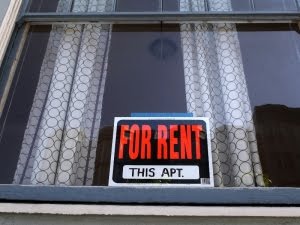
DisAbility Rights Idaho advised all Idaho colleges and universities regarding their responsibilities to provide accessible education accommodations to students with disabilities during the pandemic. It reviewed the COVID visitation policies of hospitals, offered them information about accommodation requirements under the Americans with Disabilities Act, and worked with them to craft exceptions for patients with disabilities needing assistance with communication, mobility, and mental health support.
As the pandemic spread, DRI investigated numerous complaints of abuse and neglect in residential care facilities and brought them to the attention of licensing agencies. Working with ILAS, the Intermountain Fair Housing Council and the Idaho State Ombudsman, DRI provided training on resident’s rights to long term care providers and interceded to prevent illegal evictions.
The pandemic caused many changes at Idaho Legal Aid Services offices. ILAS switched from an office-based to a remote delivery model without interruption of client service. It adopted a new online intake system to allow more people to easily apply for legal assistance. In April 2020, ILAS launched an attorney staffed “COVID-19 Legal Advice Line” to help low-income Idahoans address evolving, pandemic-related concerns. This augmented its ongoing domestic violence, housing, and senior advice lines, and remained in place for 15 months, until ILAS offices became open to the public.
All ILAS attorneys were provided with the technology, tools, and training to enable them to litigate cases via video streaming. With a spike in eviction cases, ILAS housing attorneys expanded their practice, even filing amicus briefs for pro se tenants to enforce the CARES Act eviction moratorium and collaborating with the ACLU to enforce the right to jury trial in eviction cases.
Access to Justice Idaho contributes significantly to the annual budget for the Idaho Volunteer Lawyer Program, a program of the Idaho Law Foundation. In response to the pandemic, IVLP ceased in-person clinics and implemented a new telephone clinic program. As an enhanced benefit, the telephone clinics allowed IVLP volunteers to offer vital legal advice in rural, as well as urban areas across Idaho. To service the surge of requests on housing issues, IVLP recruited attorneys to represent clients in eviction cases and offered free “eviction basics” training with CLE credit to lawyers who pledged to volunteer. As it transitions back to in-person clinics, with Access funding, IVLP plans to maintain the state-wide telephone clinics as a supplemental service.
We all hope the worst of the pandemic is over. But, with expanding delta variant infections, most certainly, we are far from returning to a pre-pandemic normal. The demand for pro bono legal assistance precipitated by the pandemic has not abated and the constraints of delivering those service are destined to persist throughout 2021 and, most likely, beyond.
The federal government’s eviction moratorium and mortgage forbearance period both expired on July 31. The CDC is now attempting to extend the moratorium until October where COVID infections are increasing, but not without legal challenge. Regardless, those with housing insecurity needing pro bono legal assistance are expected to increase substantially, extending into 2022. If the majority of Idahoans remain unvaccinated, social distancing precautions will continue in many schools, hospitals, group residential facilities, and more. Additionally, because Idaho’s population continues to grow, it is inevitable the demand for pro bono representation in cases of senior and domestic abuse, neglect and violence will persist, regardless of the pandemic.
At the Idaho State Bar Annual Meeting in July, Chief Justice G. Richard Beven advised that there are presently over 40,000 criminal cases pending in the Idaho state courts – 24% over the backlog that accumulated in 2020. With the priority of these cases, the scheduling of civil jury trials will remain challenging throughout 2021. With limited exception, remote judicial proceedings are likely here to stay. Courts in smaller Idaho counties are struggling to find alternative locations for jury trials which can accommodate safe social distancing, and the ability to finance upgraded broadband in rural counties is constraining all dimensions of remote legal services.
Most civil litigants in Idaho courts appear without counsel, largely because they cannot afford an attorney. Thus, with or without a continuing health crisis, the demand for pro bono legal services in Idaho is ever constant. And the delivery of those services will continue to exceed the capacity of the legal aid programs best suited to address the need.
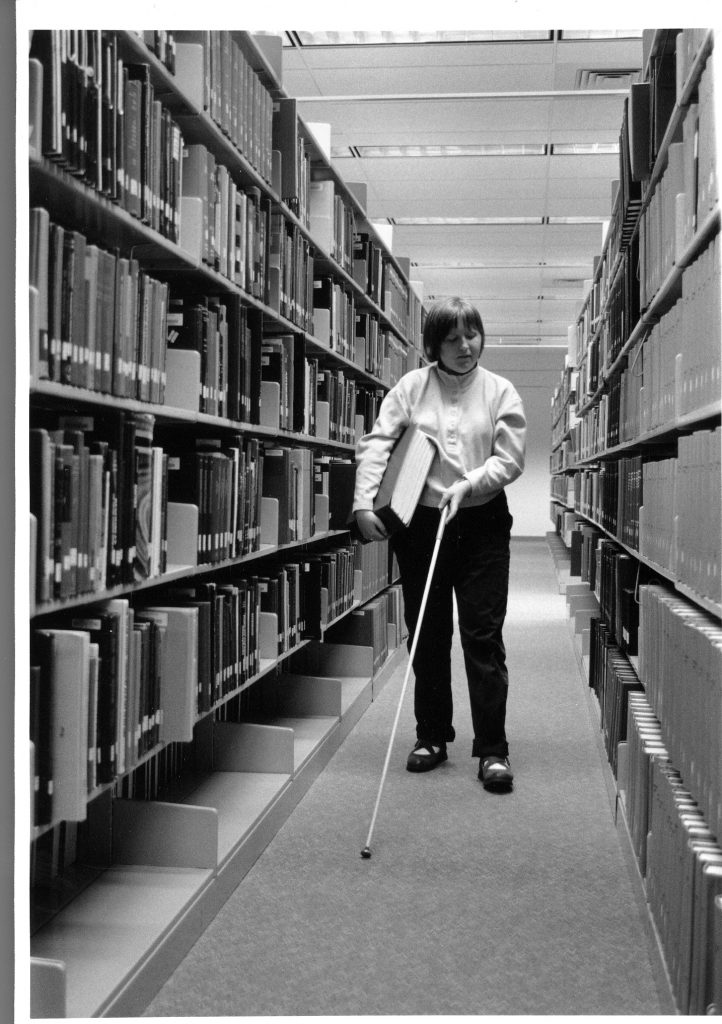
One of the core values of the legal profession is a shared responsibility for the provision of pro bono legal services to those of limited means whose access to justice will be compromised without professional advice and advocacy. Rule 6.1 of the Idaho Rules of Professional Conduct describes this as the “individual ethical commitment” of all Idaho lawyers regardless of area of public or private practice. Fulfilling this commitment, the Rule expresses two things every member of the Bar should do every year. First is rendering legal service to those in need but unable to pay “without fee or expectation of fee.” “In addition,” but often missed, “a lawyer should voluntarily contribute financial support to organizations that provide legal services to persons of limited means.”
In 2020 there was an outpouring of donations to Access to Justice Idaho exceeding $200,000, distributed to the pro bono programs it sponsors. This year, the Access Leadership Committee – comprised of 50 lawyer volunteers state-wide – has a goal to raise even more.
“In 2020 there was an outpouring of donations to Access to Justice Idaho exceeding $200,000, distributed to the pro bono programs it sponsors.”
Whether you are a repeat donor or a new convert to this noble cause, every Idaho lawyer and judge can make a generous, tax-deductible gift online without any service charge by going to http://isb.idaho.gov/ilf/accesstojustice/ and clicking the DONATE button, or by mailing your individual or firm donation directly to Access to Justice Idaho, c/o Idaho Law Foundation, P.O. Box 895, Boise, Idaho 83701-0895.
Justice for all begins with access to justice. Your gift will change lives. Please help.

Bill Mauk is native of Pocatello and a founding member of Mauk Miller & Hawkins PLLC in Boise. During his forty-six years of practice, he has handled a broad spectrum of complex civil litigation with an emphasis on employment law. For the past four years he has served as the volunteer Chair of the Access to Justice Idaho Campaign.
Building on the Legacy of the University of Idaho’s Immigration Clinic During the Pandemic

Geoffrey J. Heeren
Published September 2021
The growing presence of immigrants in Idaho is one of the reasons why the University of Idaho College of Law has had an immigration clinic since the early 2000s.[1] Immigrants make up 6% of the Idaho’s population and 8% of its labor force.[2] Moreover, Idaho’s growing immigrant population is a driving force for its economy. Immigrants—both those with lawful and undocumented status—pay tens of millions of dollars of taxes in the state.[3]
In some strategic sectors of the Idaho economy, like the enormously lucrative dairy industry in Southern and Eastern Idaho, immigrants overwhelmingly make up the work force.[4] The increasing presence of immigrants in the state—and in neighboring regions like Eastern Washington—means there is a need for attorneys to help non-citizens with an area of law that one federal court called a “labyrinth that only a lawyer could navigate.”[5]
This pressing need equates to the availability of jobs for University of Idaho law graduates trained in immigration law. The Immigration Litigation and Appellate Clinic at the University of Idaho College of law offers these opportunities. This year, the clinic adapted to the pandemic in order to continue its legacy of excellent immigrant representation. This article will provide an overview of the clinic, its recent work, and its scope.
A Leadership Transition
Prior to coming to the University of Idaho, I created an immigration clinic at Valparaiso University Law School, but the law school closed in 2019 due to declining enrollment.[6] Afterward, I was honored to be selected to lead the University of Idaho’s clinic, which has a nearly two-decade-long history, a number of litigation victories, and graduates throughout the region who have gone on to successful careers. I was happy to have a chance to build on the excellent work of my predecessors: Professors Monica Schurtman, Debbie Smith, Christina Pollard, Kate Evans, and Kathryn Railsback. The clinic is also lucky to have a great cast of highly supportive colleagues, including the Legal Administrator, Todd Bowman, Clinical Services Coordinator, Cindy Maylott, and the Director of Clinics at Idaho, Professor Jessica Long.
Moreover, Professors Evans and Railsback were generous with introducing me to some of the important local stakeholders who had developed a relationship with the clinic, including Maria Andrade, the Executive Director of Immigrant Justice Idaho, great local private immigration attorneys like Alycia Moss in Coeur d’Alene, and Marcela Pattinson, who heads an office at neighboring Washington State University dedicated to supporting non-citizen students. This strong foundation for the clinic helped assure a smooth transition.
The primary purpose of the clinic has always been to offer students the opportunity to represent actual clients with immigration law issues. These opportunities, which will be explained in greater detail in the following, include pro bono legal consultations with non-citizen students, direct representation of non-citizens before administrative agencies, delivering outreach presentations on immigration law, federal litigation, and appellate work. The clinic has often focused on cases involving clients with humanitarian claims, such as abandoned immigrant children, asylum seekers, or survivors of brutal crimes or human trafficking. The diversity and intensity of these experiences ensures that students completing the clinic will enter the practice of law with a range of experience and an appreciation for the challenges facing many non-citizens.
Counseling Local Non-Citizen Students
The clinic has had a contract with WSU for several years to offer free legal consultations to non-citizen students at the school. In the past, consultations had been primarily conducted by professors, with students serving in a supportive role. However, these consultations offered an excellent pedagogical opportunity for students to gain interviewing, legal research, and client counseling skills—particularly during a pandemic, given that WSU students were a client population that would likely be comfortable with having interviews via Zoom. As I built my plan for the clinic, the WSU interviews became an important component of our casework and curriculum, which is designed to teach students the interviewing, counseling, and legal research skills the practice of law demands.
Over the course of the year, University of Idaho students handled dozens of these interviews. After researching each WSU student’s issue, clinic students presented the issue to the class and then worked with me to develop legal advice that they offered at a follow-up session. We also ended up taking several cases that we handled on behalf of WSU students, such as cases for Deferred Action for Childhood Arrivals (DACA)—a form of relief available to undocumented immigrants brought to the US as children. Moreover, we delivered four outreach presentations for WSU students, staff, and faculty over the course of the year on the topics of immigration pathways, immigrant worker’s rights, DACA, and the new Administration’s immigration policies.
Litigation and Appellate Work
I also wanted to continue the clinic’s proud legacy of litigation and appellate work. While immigration court hearings had become difficult to arrange during the Pandemic as a result of immigration court closures and postponements, the federal court system was continuing to function well, with hearings occurring via Zoom. We took a case through the Ninth Circuit’s pro bono program on behalf of a Guatemalan woman who was detained at the Northwest Detention Center in Tacoma, Washington.[7] The case presented a host of fascinating legal issues, including the novel question of whether there is a right to counsel for non-citizens with prior removal orders who are seeking review by an immigration judge of their claim that they fear returning to their country.
Our client had presented a deeply disturbing account of violence that she fled but had been pushed through a fast-track process without a chance to bring in a lawyer to help her. The case had another heart-breaking aspect, too—the client was separated from her four children, who were living with a family member in Minnesota.
Two students, Audrey Engan and Anthony Lee, represented our client in preparing briefs before the Ninth Circuit Court of Appeals, and another two students, Rosa Cabrera Thompson and James Haws, worked to get her out of detention. In December, we succeeded in convincing the agency to release her from detention so that she could enjoy the holidays with her children for the first time in years.[8] Following up on this important interim victory for the client, Anthony Lee argued the client’s case at the Ninth Circuit Court of Appeals in April.
Our case was consolidated with two other cases raising the same novel issue concerning right to counsel, one handled by law students at an appellate practicum at Berkeley, and another by the boutique Washington DC law firm of Wilkinson Stekloff. Working with these lawyers and students to prepare for the oral argument offered Anthony an opportunity to learn about appellate lawyering from exceptional practitioners while working on an issue of national importance. On the day of the argument, he ably fielded tough questions from the panel and made compelling points for his client.
We also won release for another client this year: a longtime lawful permanent resident of the United States who was in detention because of a criminal conviction. My predecessor, Professor Kate Evans, had raised legal arguments to the agency that his conviction did not make him deportable, and continued to represent him in this case after she became the director of a new immigration law clinic at Duke. She and her students were continuing to litigate those claims as they slowly wound their way through the court system, but in the meantime, the client had been detained as of the fall of 2020 for about a year-and-a-half over the course of two stints in the Northwest Detention Center.
In our view, this prolonged period of immigration custody violated the Due Process Clause of the Constitution, and we decided to co-counsel a habeas case raising this and other claims to a federal District Court in the Western District of Washington.[9] To help with the filing, we brought on local counsel, including University of Idaho law school alumni Luis Cortes Romero and Andrew Augustine. Mr. Romero, who graduated in 2013, had gone on to serve as one of the attorneys in Department of Homeland Security v. Regents of the University of California, the case in which the United States Supreme Court held that the Government’s rescission of DACA violated the Administrative Procedure Act.[10]
Mr. Augustine, who was an alumnus of the University of Idaho immigration clinic, had joined Mr. Romero at his Seattle-based law firm. Two University of Idaho students, James Haws and Reanna Vanacore, worked alongside a team of three Duke students on the case.
In February, a Magistrate Judge issued a report and recommendation that our client be granted a bond hearing, and in June, the District Court Judge adopted the report and ordered a bond hearing.[11] The client was subsequently released as part of a settlement agreement with the Government and has now returned to his family in Southern Idaho while he pursues his immigration appeal.
Student Leadership
These cases are just two examples of the legal work that students in the immigration clinic at the University of Idaho College of Law handle. In working on these matters, students often serve in the role of lead counsel. With my help, the students are the ones who advise their clients, draft motions and briefs, and step up in court to argue a case.
This opportunity to take ownership over a case offers students a way to learn that cannot be replicated in a traditional classroom. At the same time, students achieve dramatic results for their clients.[12] I am grateful to the University of Idaho for allowing us to do this transformative work.

Geoffrey J. Heeren is an Associate Professor of Law and the Director of the Immigration Litigation and Appellate Clinic at the University of Idaho College of Law. Previously, he was a professor at Valparaiso University Law School, a clinical teaching fellow at Georgetown Law, and a Senior Attorney at Legal Aid Chicago.
Endnotes
[1] See Joel Mills, UI clinic helps immigrants with legal issues, Lewiston Tribune, July 28, 2007 (in which the clinic’s founder, Professor Monica Schurtman, explained her reasons for founding the clinic).
[2] American Immigration Council, Fact Sheet: Immigrants in Idaho (Aug. 2020), https://www.americanimmigrationcouncil.org/research/immigrants-in-idaho.
[3] In 2018, immigrant-led households in the state paid $419.5 million in federal taxes and $220.9 million in state and local taxes. Undocumented immigrants alone paid an estimated $31.1 million in federal taxes and $22.5 million in state and local taxes in 2018. Id.
[4] Idaho now ranks third in the nation in milk production, with much of the dairy industry concentrated in the Magic Valley, Treasure Valley, and Eastern Idaho. See Idaho Dairymen’s Association, Idaho Dairy Statistics, https://www.idahodairymens.org/economic-impact. That is part of the reason why the Idaho Dairymen’s Association has supported and worked for immigration reform to address the status of undocumented workers. Bill Dentzer, Trump Deportations would hit Idaho ag, where a fourth of all workers are undocumented, Idaho Statesman, Nov. 12, 2016.
[5] Ram v. Mukasey, 529 F.3d 1238, 1242 (9th Cir. 2008) (quoting Biwot v. Gonzales, 403 F.3d 1094, 1098 (9th Cir. 2005).
[7] The client has given informed consent for me to generally describe the facts of her case without disclosing her name.
[8] Rachel Spacek, Asylum seeker reunited with family from efforts of U of I immigration law clinic, Idaho Mountain Express, Dec. 25, 2020.
[9] Gretel Kauffman, Detained by ICE with no bond hearing, Idaho man takes legal action, Idaho Press, Nov. 20, 2020 (describing habeas petition filed by University of Idaho College of Law Immigration Clinic in collaboration with the Immigrant Rights Clinic at Duke).
[10] See Kip Hill, Idaho law school graduate who helped argue DACA case lauds Supreme Court decision, Spokesman-Rev., June 18, 2020.
[11] Juarez v. Wolf, No. C20-1660-RJB-MLP, 2021 WL 2323436 (W.D. Wash. May 5, 2021), report and recommendation adopted, No. 20-1660 RJB – MLP, 2021 WL 2322823 (W.D. Wash. June 7, 2021).
[12] As a law school clinic, our primary mission will always be to educate our students, and we therefore take a very modest number of cases each year and cannot come close to meeting the growing need for immigrant legal aid in the state. However, if a reader has a case that they believe would be an appropriate referral, they can contact the clinic at (208) 885-6541. We prioritize cases involving asylum applicants, survivors of human trafficking, crimes, and domestic abuse, and children who have been abused, abandoned, or neglected.
The Entrepreneurship Law Clinic

John B. Hinton
Published September 2021
Have you ever had a prospective client who had an intriguing idea for a business but lacked the funds to hire you? Or perhaps they wanted to start a non-profit organization but just did not have the capital to pay for legal services. These are the type of clients that often get referred to the Entrepreneurship Law Clinic (ELC) at the University of Idaho College of Law.
The ELC is one of the College of Law’s clinical programs, where third year law students build practical skills while helping clients who generally cannot afford to hire a lawyer. Other clinics at the college include the Main Street Law Clinic, the Immigration Litigation & Appellate Clinic, the Housing Clinic, and the Family Justice Clinic.
The clinical programs are an important part of the law school. They give students the opportunity to learn practical skills while helping the communities of Idaho. Students participating in the clinics are granted limited licenses to practice law and are supervised by law professors who are admitted to practice in Idaho. All the clinical programs at the U of I offer something different. However, regardless of the program chosen, students leave these clinics better prepared to practice law either as an associate in a law firm or in government service.
The ELC
The ELC differs from some of the college’s other clinics in that it is focused on a transactional type of law practice. This means students help clients form business entities and non-profit organizations as well as obtain federal trademarks, draft and review contracts, deal with e-commerce issues, and the many other legal concerns of a fledgling entity.
Students at the clinic learn how to interview clients, draft engagement letters, consider ethical issues (such as, for example, those presented by dual representation of multiple clients), research and file trademark applications, draft organizational business entity documents, and consider common income tax issues related to business formation.
In addition to the real legal issues presented by the clients themselves, students also study practical transactional issues faced by entrepreneurs through class lectures. Finally, students learn legal practice and management skills and tips on how to succeed as a law firm associate. One of the more important skills they learn is how to track mock “billable hours” for all their client work.
The Clients
What types of clients does the ELC represent? As mentioned, many of the clients are referred to the clinic by other lawyers because the clients cannot afford to hire private counsel. Some of the clients are students themselves, usually either college or graduate students. This past semester the clinic also represented an 18-year-old high school student with an idea for a computer application.
A significant portion of the clinic’s client base includes small, non-profit organizations covering a broad range of charitable purposes, from helping to stop human trafficking to promoting a well-known Idaho city, to encouraging healthy physical activities for children in elementary schools. Several of the clients are inventors with ideas for new products or services. The range of ideas from the most recent school year has included everything from podcasts to board games to micro-brewed beers to various software and computer applications.
Perhaps the largest group of clients are aspiring entrepreneurs with ideas for small businesses. Some recent clients have included a resume coaching business for individuals reentering the workplace, a web-based service to help school teachers, a company that provides business consulting to women, a floral studio, a local moving company (two guys and a rented truck), a personal exercise trainer, a business that makes puzzles and board games, a company that makes survival gear, a coffee shop, a company that makes handmade jewelry, a business which creates camping products, and an Idaho based woodworker. While this is not a complete list of the types of clients helped by the clinic, it provides some insight into the diverse group of entrepreneurs with whom the students get to work.
The services performed for these clients included business formation and reorganizations, the creation of non-profit organizations, securing trademarks, advice concerning other intellectual property concerns, advice concerning employee and independent contractor issues, drafting user agreements and privacy policies, reviewing and drafting contracts of all types, creating employee handbooks, drafting a HIPAA policy, and of course dealing with legislation related to the COVID-19 virus.
Insert Break Out Box with the following:
The issues dealt with by the clinic are wide ranging. Here are a few examples:
Most of these clients have little or no experience working with attorneys, so clinic students try to be good ambassadors for the legal profession as well as preparing the clients to transition to working with private counsel on an ongoing basis after they leave the clinic. The clinic often advises clients to seek the help of a lawyer in the future when there is a change in their business such as adding an additional owner or hiring an employee. Some of the clinic’s past clients have grown to much larger organizations able to retain private counsel.
Issues dealt with:
The issues dealt with by the clinic are wide ranging. Here are a few examples.
- The creation and use of business plans.
- The protection of trademarks and other intelletual property.
- The formation of businesss entities and non-profit organizations.
- Income and payroll tax considerations in business formation, operation, and liquidation.
- Using business entities to further estate planning goals.
- Contracts of all kinds including leases, non-disclosure agreements, buy-sell agreements, customer, and vendor agreements.
- Business finance concerns including those presented by funding from friends, family, and others.
- E-commerce issues and electronic transactions including drafting website user agreements and privacy policies.
- Advertising concerns under state law as well as compliance with the Lanham Act and Federal Trade Commission Act
How the Clinic Works
Clients who come to the clinic are assigned to work with one or more students. A client with more complex matters may have two or three students assigned to them. Once assigned, the students typically set up a meeting with the client and their supervising attorney. After meeting with the client, the students prepare an engagement letter to be signed by the client, and then commence performing the legal services needed.
All the clinic students get together in a weekly meeting to discuss the matters they are working on with each other and their supervising professors. The students thus learn from each other and are exposed to legal issues presented by matters other than their own. In this way the clinic operates much like a law firm or practice group that has collaborative meetings among colleagues.
The relationship between the students and their supervising professor is also similar to that of a law firm associate and a partner in the firm. All work is reviewed by the supervising professor before presenting it to the client. However, students in the clinic generally have more direct contact with clients than do many law firm associates.
Most matters are started and completed by the same students. However, trademark matters usually take the longest and often span more than one school year. In such cases, students will write a memo to the file to be read by incoming students in the Fall.
Students who participate in the clinic benefit from the experiential learning approach. They leave the clinic much better prepared to be an associate in a law firm or enter a governmental law practice. Although these students have already developed the skills of reading cases and understanding the law at an intellectual level, the ELC and the other clinics at the U of I give students a chance to apply this knowledge to provide practical solutions to help their clients.
Most law students never really know what it is like to practice law until they have their first client. When they do, they quickly appreciate it is not the same as the legal shows on TV. Instead, practicing law is better than TV, because the clients helped are real.
Insert Breakout Box with the following:
Contact Information
To contact the Entrepreneurship Law Clinic at the University of Idaho, please contact the Director of the Clinic: John Hinton at jhinton@uidaho.edu If you know a prospective client you wish to refer to the Entrepreneurship Law Clinic, please contact the Director of the Clinic (see side bar for contact information).

John B. Hinton is the Director of the Entrepreneurship Law Clinic. Along with Professor Alexandra Hodson, he supervises third year law students participating in the ELC. He also teaches Federal Income Taxation at the University of Idaho College of Law.
A Housing Crisis: The Story of the Syringa Mobile Home Park and the Law Clinic’s Quest for Water
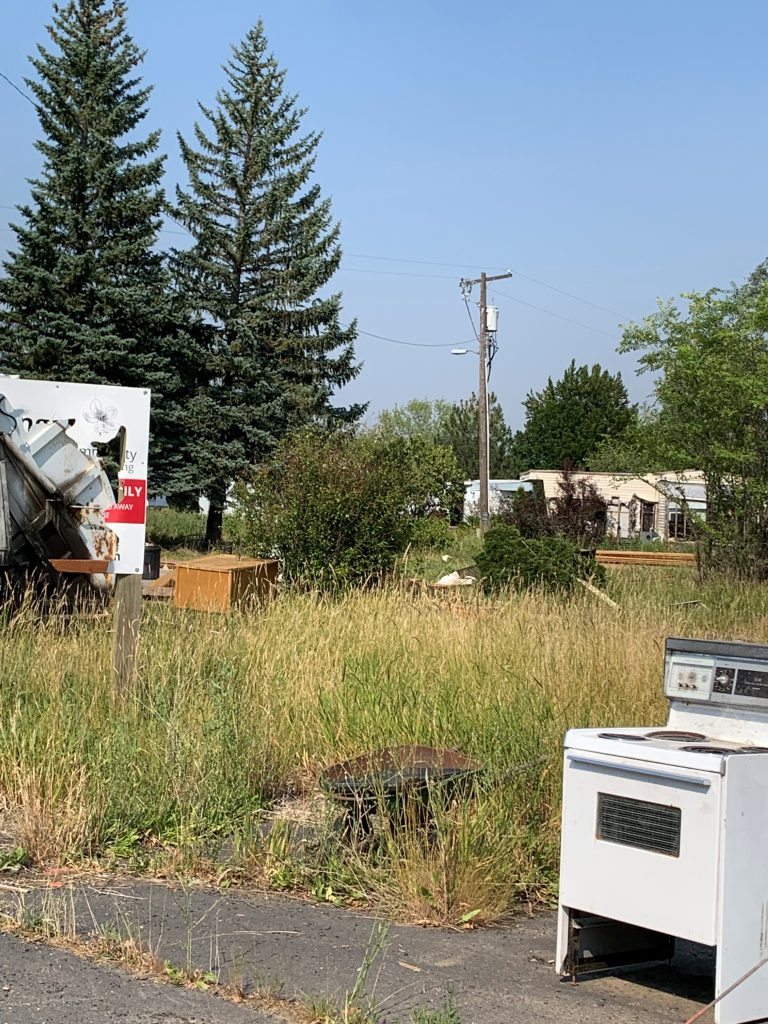
Jessica M. Long
Published September 2021
What would you do if you had to live in a home without water? If the water coming out of your home’s pipes was contaminated? On average, a person uses between 80–100 gallons of water per day for indoor uses.[1] But if that water was contaminated, how would you fill the coffee pot in the morning, brush your teeth, shower, wash clothes, prepare meals, give your pets water to drink? How would you cope until your water was declared clean and safe to use again?
For the residents of the Syringa Mobile Home Park, this is the nightmare they found themselves living in for 93 days. And for seven years, this would be the biggest challenge the University of Idaho College of Law’s Legal Aid Clinic would face – a class action lawsuit against the owner of the Mobile Home Park, beginning in state court in February of 2014 and ending in bankruptcy court in March of 2021.[2] This is the story of how 25 legal interns, under the supervision of Professor Maureen Laflin and Associate Clinical Professor Jessica Long, tried to help the residents of Syringa in their fight to secure safe water and compensation for having to endure without safe water for over three months.
The Place
The Syringa Mobile Home Park (“Syringa”) was located in Latah County, approximately three miles from the University of Idaho. It was surrounded by the rolling hills of the Palouse and beautiful views of Moscow Mountain. Syringa opened in the 1970’s. Long term former residents told us that Syringa was once a coveted place to live, with newer mobile homes, big lots with trees and lawns between the homes, a large community rec center with an indoor pool, and community events throughout the year.
In the early 1980’s, a man by the name of Magar E. Magar bought Syringa. Over the next 30 years, Syringa declined. Mr. Magar bought several of the mobile homes in the park, then let them deteriorate. The roads around Syringa were not maintained and became uneven and riddled with potholes. When the pool broke, it was covered up by plywood. The community rec center closed. And there were constant problems with the drinking water and wastewater systems. Syringa had several wells that provided water to the residents, along with three sewage lagoons for wastewater disposal. Beginning in 1986, the Department of Environmental Quality (“DEQ”) brought numerous administrative actions against Magar for various problems with the fresh water and wastewater systems at Syringa. The DEQ filed suit against him in 2014.[3]
The Problem
In December 2013, the residents of Syringa discovered that they were without water. This was not a new occurrence at Syringa. Residents reported that there were often periods when the water system did not work. Typically, it was because the pumps for the wells had malfunctioned and the pressure in the system had dropped. The water outages usually lasted less than a day.
On December 18, 2013, the water came back on. But testing of the water showed high levels of coliform bacteria, a bacteria found in feces, as well as lead in the water. The residents could, in theory, still use the water for bathing, laundry, and flushing their toilets, but the water was not safe for drinking, even after boiling it. Residents suspected that the people working on the system began heavily chlorinating the water to kill the coliform bacteria. Residents reported that the water smelled like bleach. Residents who used the water to shower and bathe reported burning skin and rashes. Residents who inadvertently consumed the water reported abdominal cramps, diarrhea, and vomiting.
The Legal Aid Clinic began receiving calls right at the end of the winter academic break. By then, the residents had gone over two weeks without drinking water.
In February, a cold snap hit North Idaho and the poorly maintained sewage pipes at Syringa froze. For nearly two weeks, some residents could not even flush their toilets. The manager and her husband went to work unclogging and repairing the system, while community groups came out and helped thaw the residents’ pipes. When the sewage pipes eventually thawed and water began flowing through them again, the backed-up sewage came out of the toilets and bathtubs. Sewage spilled onto the floors and soaked into the residents’ carpets. And the residents were all still without drinking water.
The People
The legal interns started their work in January 2014 with a visit to Syringa to interview the residents. At this time, it was unknown how many people even lived there. The legal interns went door-to-door, talking with the residents, gathering information, and getting a headcount.
The legal interns learned that some of the residents rented their homes from Magar and paid rent to him. Others rented their homes from third parties and paid lot rent to Magar. Still others owned their mobile homes and paid lot rent to Magar.
The legal interns talked with people who had lived at Syringa for over 30 years, who remembered celebrating holidays in the community rec center and swimming in the indoor pool. They talked with others who were working full-time and struggling to make ends meet, and Syringa was the only place they could afford to live. There were veterans suffering from PTSD living at Syringa, who found the park’s location outside of town peaceful. There were people struggling with substance abuse and mental health issues. And there were people who had felony convictions that, because of their convictions, could not find housing elsewhere. While their reasons for living and remaining at Syringa varied, all of them were being harmed by not having safe water to drink.
The Case
Under Idaho Code Sec. 6-320, a landlord is required to maintain in good working order the electrical, plumbing, heating, ventilating, cooling, or sanitary facilities supplied by the landlord.[4] The landlord is also prohibited from maintaining the premises in a manner that is hazardous to the health and safety of the tenant.[5] However, before a tenant can file a lawsuit against the landlord for violations of Idaho Code Sec. 6-320, the tenant must first give three (3) days written notice to the landlord demanding specific performance to cure the violations.[6]
Similarly, under the Manufactured Homes Residency Act, the landlord is required “to maintain in good working order, to the terminal point of service, electrical, water or sewer services supplied by the landlord.”[7] The landlord is also prohibited from “maintaining the premises in a manner hazardous to the health and safety of the resident including… a continuing violation of (i) any rule adopted by the department of environmental quality governing public drinking water systems, and (ii) any rule adopted by the department of environmental quality governing hazardous waste.”[8] Under this act, a resident must similarly give the landlord three (3) days written notice demanding specific performance to cure the violations prior to filing suit.[9]
Three residents agreed to serve as the class representatives for the lawsuit: one of Magar’s tenants and the other two homeowners renting lot space from Magar. Magar was given three (3) days written notice, listing each statutory violation, and demanding specific performance to cure the violations. When no actions were taken, the clinic filed a class action against Magar on February 26, 2014.

At this point, things were desperate for the residents and the primary goal was to get them water. When the class action lawsuit was filed against Magar, there were already two cases pending against him for his mismanagement of Syringa. The first was by the Idaho Conservation League, because contaminated water from Syringa’s sewage lagoons had flowed into the South Fork of the Palouse River. The second was by the Department of Environmental Quality for violations pertaining to Syringa’s drinking water system.
The clinic first sought a preliminary injunction, seeking to have Magar fix the drinking water system, and provide bottled water, bathrooms, showers, and laundry facilities to the residents until the system was working again. The motion for a preliminary injunction was set for a hearing on March 25. On March 20, 2014, five (5) days before our hearing, the water at Syringa was declared safe to drink again.
But because of concern that the problems were far from over, the clinic went forward with the hearing. Judge Stegner, then district judge for Latah County, granted the injunction and ordered Magar to keep the system working, and do routine maintenance and repairs as needed to ensure the drinking water system did not fail again. If it did malfunction, Magar needed to provide water to the residents.
The class action lawsuit moved forward, seeking permanent fixes to the water and wastewater systems, and compensation for the residents for having to endure 93 days without water.
The clinic and Magar participated in mediation in the summer of 2014. Magar agreed to do regular, preventative maintenance and repairs to the drinking water and wastewater systems, but he would not agree to pay the residents any money. So, the issue of money damages was set for a hearing. After numerous continuances, a hearing on damages was set for March 31, 2015. On March 27, 2015, the Friday before our hearing on damages, Magar filed for bankruptcy.
Meanwhile, at the park, the residents were still struggling. The water system still periodically malfunctioned. The sewage lagoons still periodically overflowed. Because of the unstable conditions, Latah County’s Planning and Building Department condemned the entire mobile home park. As people vacated their homes, the county came in and condemned the home. As a result, no new residents could move into Syringa. If people wanted to sell or rent their homes and move out, the people buying or renting their homes could not move in. Since it cost thousands of dollars to move a mobile home, this was not a viable option for most residents. So many residents simply abandoned their homes and left.
In December 2016, NPR did a story on Syringa called: Mobile Home Park Owners Can Spoil an Affordable American Dream, which discussed the challenges of being mobile homeowners—stated simply, they own their homes, but they don’t own the land under their homes.[10]
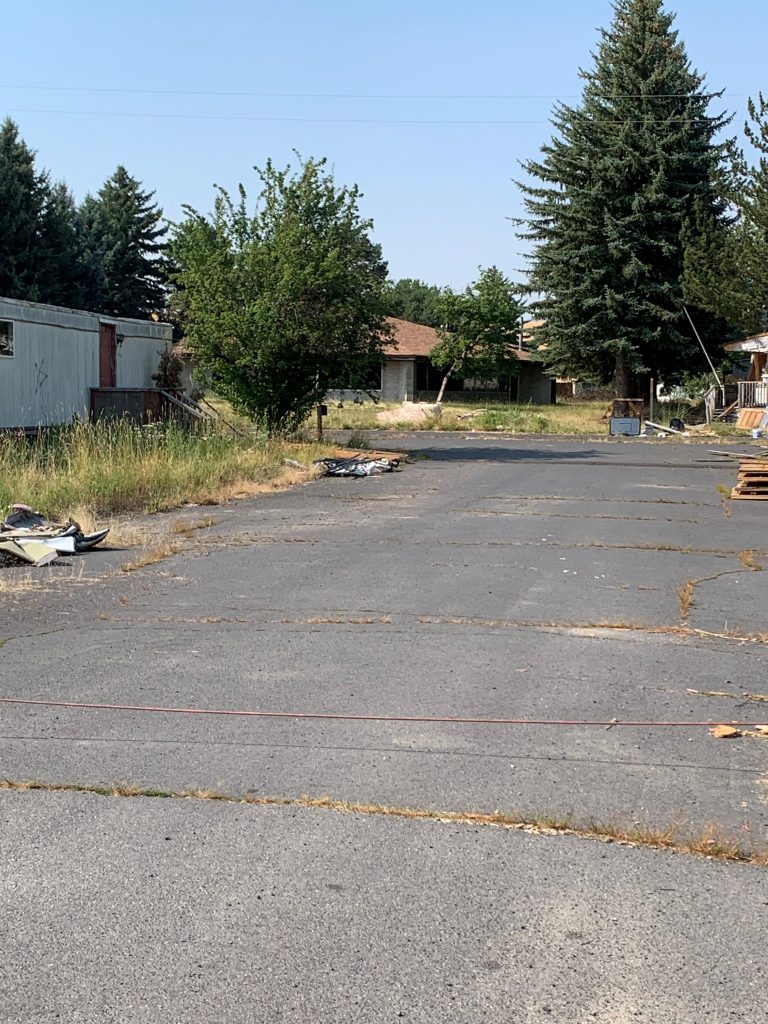
On November 13, 2017, the unsecured creditors in Magar’s bankruptcy participated in mediation with Magar’s representatives and were able to reach a settlement. Under the terms of that settlement, the residents of Syringa, including those who had recently moved, received some money to pay for moving expenses, to reimburse them for their lost homes, and to compensate them for having to live in Syringa without water. Magar was also required to keep the park open until June 5, 2018, so residents would have adequate time to move out. The money was distributed in the summer of 2018 and the park subsequently closed.
As part of the bankruptcy, the sewage lagoons were drained and decommissioned and the land was sold. Magar passed away on August 16, 2018. If you drive by Syringa today, you will still see abandoned mobile homes, most damaged and graffitied, a boarded-up community center, a dilapidated playground, buildings partially torn down, and personal property scattered about the grass and roads.
The Conclusion
“Syringa exposed the challenges facing residents of mobile home parks. For those renting a mobile home from the landlord, their only option is to sue for damages.”
In total, 25 legal interns worked on the Syringa case over its seven-and-a-half-year duration. The knowledge they gained and the opportunities they had were impressive. The interns had to master the rules of civil procedure, particularly those dealing with class actions, while learning contract law, tort law, and landlord-tenant law. They drafted complex pleadings – a class action complaint; motions to certify the class, for a preliminary injunction, for contempt, to compel; briefs; affidavits; declarations; discovery requests; and subpoenas. They engaged in the discovery process, including taking depositions and subpoenaing records. They took part in negotiations and mediations. And they participated in numerous hearings.
They learned to work with experts: the hydrogeologists testing the water, a ground water engineer, a doctor, government officials, other lawyers[11], and law professors with expertise in civil procedure, contracts, torts, real property, landlord-tenant law, environmental law, bankruptcy, tax law, and professional responsibility.
And finally, the legal interns learned how to talk and connect with their clients. They went into the residents’ homes; they saw where and how they lived; they listened to their stories; they witnessed their struggles. They held meetings and updated the residents on the case. They helped explain how the case was progressing. They handed out checks from the settlement, celebrated with the residents who moved on to better places, and commiserated with the ones who were struggling to leave. They honed their advocacy skills and fought for the residents until the very end.
Syringa exposed the challenges facing residents of mobile home parks. For those renting a mobile home from the landlord, their only option is to sue for damages. The same is true for those owning their homes and paying lot rent to the landlord. Neither is legally entitled to withhold rent until the problem is fixed.
For those renting from third parties, their options are more limited. They have no contractual relationship with the mobile home park owner and thus no avenue of redress under landlord-tenant law. Instead, they have to pursue an action against their own landlord, who ultimately has no control over the problem and thus no ability to remedy it. And as many of the homeowners at Syringa discovered, a mobile home park owner can close a park with a mere six months’ notice.[12] If the homeowner cannot arrange for their home to be moved, they simply have to abandon it. This is what many of the homeowners at Syringa had to do.
The following is a list of the legal interns who worked on this case over the years:
- Michaela Adams
- Sara Archibald
- Tracey Poulos (formerly Calderon)
- Lauren Ellis (formerly Chambard)
- Auriana Clapp-Younggren
- Christine Dodd
- Shea Line
- Sandra Lockett
- John Michael McCracken
- Tyler Naftz
- Kevin Page
- Desiree Seal
- Alexander Sosa
- Donald “Joe” Towslee
- Craig Watt
- Michael Wilder
- Brennan Wright
- Eight additional legal interns worked on portions of the case, but consent to publish their names could not be obtained prior to publication.
Ultimately, the residents are at the mercy of the mobile home park owner, with little recourse when problems, such as a malfunctioning water or wastewater system, happen. But those issues (and possible solutions) are for another article. For now, as the clinic closes our files, we focus on the people we served, the challenges we faced, and the work we performed in our effort to obtain a safe and healthy living environment for the residents of the Syringa Mobile Home Park.
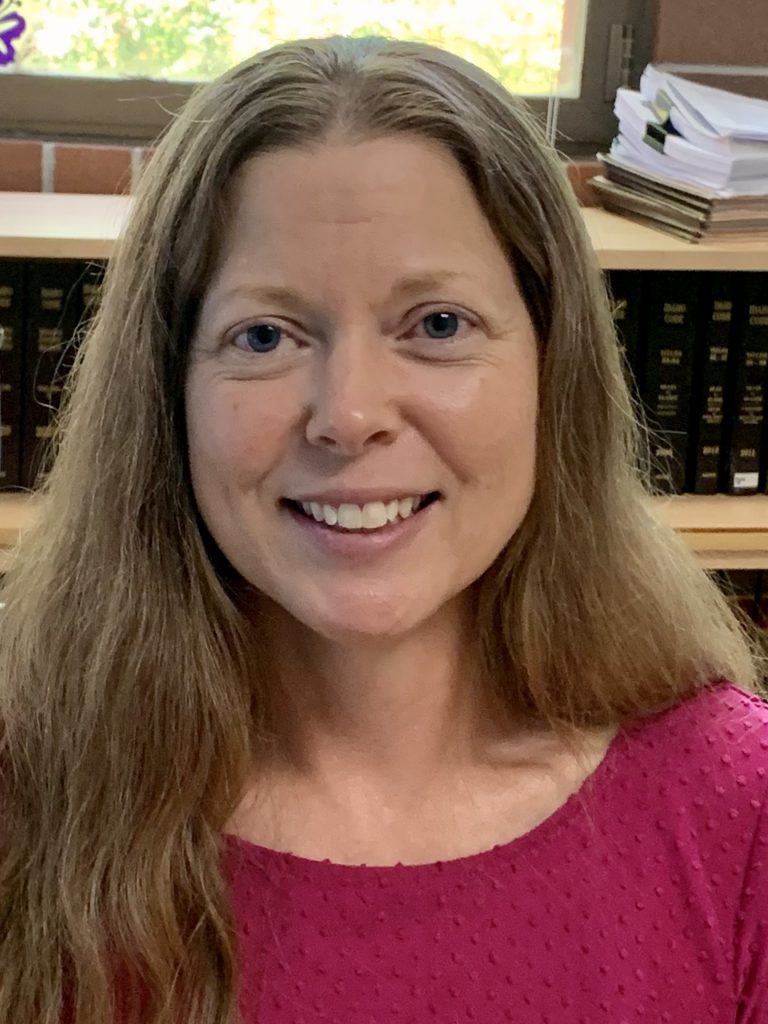
Jessica M. Long is an Associate Clinical Professor at the University of Idaho College of Law. Professor Long supervises the Main Street Law Clinic, serves as Director of Clinical Programs, runs the College of Law’s Trial Advocacy Program, and teaches Lawyering Process.
Endnotes
[1] https://www.usgs.gov/special-topic/water-science-school/science/water-qa-how-much-water-do-i-use-home-each-day?qt-science_center_objects=0#qt-science_center_objects.
[2] Page v. Magar, 2d Jud. Dist. of Idaho, County of Latah, Case No. 2014-227; In re Magar E. Magar, Case No. 15-41415-MJH (Bankr. W.D. Wash. filed Mar. 27, 2015 and terminated Mar. 11, 2021).
[3] Idaho Dept. of Envt’l Quality v. Magar, 2d Jud. Dist. of Idaho, County of Latah, Case No. 2014-121.
[4] Idaho Code § 6-320(a)(2).
[5] Idaho Code § 6-320(a)(3).
[6] Idaho Code § 6-320(d).
[7] Idaho Code § 55-2014(1)(a).
[8] Idaho Code § 55-2014(1)(b)(i)(ii).
[9] Idaho Code § 55-2014(5).
[10] https://www.npr.org/2016/12/26/502590161/mobile-home-park-owners-can-spoil-an-affordable-american-dream.
[11] Attorney Duncan Palmatier served as co-counsel for a portion of the class action lawsuit. Attorneys Ford Elsaesser and John (J.D.) Nellor represented the unsecured creditors committee in Magar’s bankruptcy case.
[12] Idaho Code § 55-2010(d).
How the U.S Constitution Connects with COVID-19

Richard H. Seamon
Published September 2021
Every semester, I tell the students in my course on constitutional law at the University of Idaho College of Law that it is a great time to be taking constitutional law. And every semester that proves to be true. Recent events during the COVID-19 pandemic have raised many issues of constitutional law useful for class discussion. In the following, I discuss one such event: the federal residential eviction moratorium. The moratorium arguably exceeds the federal government’s statutory and constitutional powers. In the following discussion of the moratorium’s legal vulnerability, you will encounter cases that you might remember from your own law school course in constitutional law. I hope the discussion shows the continuing vitality and central relevance of the U.S. Constitution to the challenges that confront our country today.
Introducing the CDC’s Eviction Moratorium
In the pandemic-relief law known as the “CARES Act,” Congress put a six-month moratorium on certain residential evictions.[1] After that moratorium expired in July 2020, Congress did not renew it. Instead, a new eviction moratorium was put in place by the Centers for Disease Control and Prevention (CDC), a federal agency within the U.S. Department of Health and Human Services.[2] The CDC’s eviction moratorium expired on July 31, 2021, despite last minute pressure on the White House and Congress to extend it.[3] In light of the looming expiration, the Idaho Judicial Branch started a pilot program in Ada County that invites landlords and tenants in eviction suits to negotiate settlement agreements through an online portal.[4]
The CDC eviction moratorium applied to all residential housing in the United States. To get protection under the moratorium, a tenant had to show that he or she had fallen behind in rent because of job loss, a cut in working hours, or extraordinary medical expenses. The tenant also had to show that he or she could not find alternative housing other than “congregate” housing like a homeless shelter. A landlord who evicted a tenant in violation of the moratorium faced up to one year in prison and a fine of up to $250,000.[5]
The CDC issued the moratorium under the Public Health Service Act. That federal law authorizes the CDC to issue “such regulations as in [its] judgment are necessary to prevent the introduction, transmission, or spread of communicable diseases . . . from one State . . . into any other State.”[6] The CDC explained that the eviction moratorium could limit the spread of COVID-19 in three ways. It could facilitate self-isolation by people who get COVID-19. It could help States and local governments implement stay-at-home orders. Finally, it could prevent people from ending up on the street or in homeless shelters, where COVID-19 is more easily spread.[7]
Thus, the CDC justified its eviction moratorium as a public health measure. That is important because the U.S. Constitution does not expressly authorize the federal government to issue public health measures. And so a student of the U.S. Constitution naturally wonders whether it authorizes the CDC’s eviction moratorium. This question of the federal government’s power involves three issues that are covered in a law school course on constitutional law and are discussed as follows: the limited powers of the federal government; Congress’s power over interstate commerce; and the delegation doctrine.
The Limited Powers of the Federal Government
The U.S. Constitution creates a federal government of limited powers. But to grasp this point fully, law students must learn that the limited powers granted by the Constitution can include implied powers under the U.S. Supreme Court’s decision in McCulloch v. Maryland.[8]
In McCulloch, the Court held that Congress had power to create a national bank. The Court acknowledged that “[a]mong the enumerated powers, we do not find that of establishing a bank.”[9] That was not fatal, the Court concluded, because the Constitution gives implied (as well as express) powers to Congress. The Court based this conclusion partly on the Constitution’s Necessary and Proper Clause, which the Court interpreted to recognize Congress’s power to enact all measures that are reasonably necessary to execute the enumerated powers.[10]
The McCulloch Court held that the creation of a national bank fell within Congress’s implied powers, as reflected in the Necessary and Proper Clause. The Court reasoned that the bank was a reasonably necessary way for Congress to execute various enumerated powers. Those powers included the powers to lay and collect taxes (with the national bank serving as a depository of those taxes); to borrow money (with the bank serving as the federal government’s lender); and to regulate commerce (with the bank’s notes serving as a form of national currency). And so, after all, the national bank was a “necessary and proper” way of executing several enumerated powers.
The McCulloch Court’s recognition of “implied powers” underlay the federal government’s expansion in the twentieth century. As one website says, “Ultimately, McCulloch v. Maryland made possible the rise of . . . ‘the administrative state,’ in which the government employs officials to oversee many aspects of American life, from environmental issues to labor disputes.”[11] This conclusion is incomplete, though. To appreciate the connection between McCulloch and today’s “administrative state,” the student of constitutional law must learn (1) how McCulloch’s concept of implied powers combines with Congress’s power to regulate interstate commerce and (2) how the Court’s delegation doctrine allows Congress to transfer huge hunks of its Commerce power to federal executive-branch agencies.
The implied powers, in effect, enlarge the enumerated powers. This enlargement has been most significant as applied to Congress’s power to “regulate Commerce . . . among the several States.”[12]
Congress’s Commerce Power
The implied powers of Congress recognized in McCulloch and reflected in the Necessary and Proper Clause can be exercised only in connection with Congress’s execution of its expressly enumerated powers. The implied powers, in effect, enlarge the enumerated powers. This enlargement has been most significant as applied to Congress’s power to “regulate Commerce . . . among the several States.”[12]
As enlarged by implied powers, Congress’s Commerce power was held in United States v. Lopez to authorize Congress to regulate three categories of activity:
First, Congress may regulate the use of the channels of interstate commerce. Second, Congress [may] . . . regulate and protect the instrumentalities of interstate commerce, or persons or things in interstate commerce. . . . Finally, Congress [may] . . . regulate . . . those activities that substantially affect interstate commerce.[13]
The third category is reachable by Congress largely because of its implied powers. The classic case illustrating this is Wickard v. Filburn.[14] There, the federal government fined Roscoe Filburn for growing more wheat than allowed under a federal statute. Mr. Filburn consumed all of this excess wheat on his own farm. The Court upheld Congress’s power to regulate a farmer’s growing his own wheat for his own on-farm consumption. The Court reasoned, in part, that regulation of this type of activity was necessary to protect Congress’s ability to regulate interstate commerce in wheat. It was thus justified as a means that was reasonably necessary to executing the Commerce power over the commodity. To support this conclusion, the Wickard Court cited McCulloch v. Maryland.[15]
Today, we would say that Congress could regulate Farmer Filburn’s growing of “excess wheat” for his own use because that activity—when considered in the aggregate—substantially affected interstate commerce in wheat and thus fell within Congress Commerce power (as enlarged by the implied powers reflected in the Necessary and Proper Clause). The Commerce power, as amplified by the Necessary and Proper Clause, underlies most federal statutes on the books today, including federal anti-discrimination laws, environmental protection laws, and, most relevant here, public health laws.
So far, we’ve established Congress’s power to regulate activity that substantially affects interstate commerce. We still must connect that power of Congress to federal executive-branch agencies like the CDC. The connection lies in the delegation doctrine.
The Delegation Doctrine
The delegation doctrine allows Congress to authorize federal agencies to make rules that have the “force and effect of law.”[16] These rules are called “legislative rules” to indicate that their legal effect is tantamount to that of federal statutes.
Early on, the U.S. Supreme Court rejected the argument that, by allowing federal agencies to make legislative rules, Congress was abdicating its duty to exercise “[a]ll legislative Powers” vested in it by the U.S. Constitution.[17] The Court takes the position that federal agencies exercise only a “quasi-legislative,” not a purely legislative power.[18] The Court insists, however, that in granting this power, Congress must prescribe an “intelligible principle” for the agency to follow when making legislative rules. Thus, the federal statute that grants rulemaking power must put comprehensible (“intelligible”) restrictions on that power.
In applying the “intelligible principle” standard, the Court has upheld exceptionally broad grants of rulemaking power to federal agencies. For example, the Court upheld the federal statute that allows the Occupational Safety and Health Administration (OSHA) to make workplace safety rules. The statute requires the rules to be “reasonably necessary or appropriate to provide safe or healthful employment [which] most adequately assure[], to the extent feasible, on the basis of the best available evidence, that no employee will suffer material impairment of health.”[19]
It does not matter that this statute is full of fuzzy wiggle words like “reasonably necessary or appropriate,” “adequately assure,” “to the extent feasible,” and “material impairment.” Nor does it matter that the rules cover all businesses that are engaged in interstate commerce or whose activities substantially affect interstate commerce. Under the Court’s delegation doctrine, OSHA can prescribe national workplace safety policy for almost the entire private sector.
Revisiting the CDC’s Eviction Moratorium
At this point, we can fully analyze the CDC’s power to issue the eviction moratorium. Analysis entails three questions:
- Does the nationwide eviction moratorium fall with the CDC’s power under the Public Health Service Act? If so, two further questions arise:
- Does the Act violate the delegation doctrine?
- Does the Act fall within Congress’s power?
Only questions two and three are questions of constitutional law. Question one involves statutory interpretation, but it is influenced by constitutional concerns, as shown in a recent decision by the U.S. Court of Appeals for the Sixth Circuit, Tiger Lily, LLC v. U.S. Dep’t of Housing and Urban Development.[20]
The court in Tiger Lily held that CDC’s eviction moratorium was not authorized by the Public Health Service Act. The court relied partly on its belief that the Act “could raise a nondelegation problem” if it were interpreted to authorize the moratorium. The court explained that such an interpretation “would grant the CDC director near-dictatorial power for the duration of the pandemic.”[21] The apparently limitless scope of power entailed by the CDC’s favored interpretation would mean that the statute necessarily lacks an “intelligible principle” restraining agency discretion. As such, the statute would violate the nondelegation doctrine if the CDC’s interpretation were adopted.
The Tiger Lilly court also believed that an expansive interpretation of the Act urged by the CDC would “push the limit of congressional authority” and for that reason, too, must be avoided.[22] The “congressional authority” that the court had in mind was Congress’s authority under the Commerce Clause. Although the CDC argued that the moratorium regulated activity that substantially affects interstate commerce, the argument was a stretch in the court’s view. That was so for three reasons.
First, the eviction moratorium did not regulate a commercial transaction like the rental of housing. Indeed, it didn’t alter tenants’ contractual obligation to pay rent. It just restricted a legal remedy—one that usually would be sought in a state court—for nonpayment. Nor was the moratorium a reasonably necessary part of a broader federal scheme for regulating the real estate market.
Second, the connection between the eviction moratorium and the interstate movement of people was highly attenuated. The Texas court found that, while about 15% of residential moves are interstate, only a small percentage of residential moves result from evictions. Marital breakups account for ten times as many residential moves as do evictions, and yet it’s doubtful that the federal government can regulate divorce, as family law is an area of traditional state concern.[23]
Third, a federal eviction moratorium is unprecedented. In the past, eviction moratoria have been thought to fall within the States’ police power.[24] The federal government’s failure to exercise a power that would be so appealing in response to events like the Spanish Flu of 1919-1920 and the Great Depression tends to suggest that the power does not exist.
Thus, the Sixth Circuit’s decision in Tiger Lily implies that the moratorium’s constitutionality is dubious because of the nondelegation doctrine and the limits on Congress’s Commerce power.
The D.C. Circuit, however, came to opposite conclusions in Alabama Ass’n of Realtors v. U.S. Dep’t of Health and Human Services.[25]The D.C. Circuit’s decision has limited precedential value, as it was a short per curiam opinion issued on appeal from a district court’s grant of a stay pending appeal. Even so, the decision is significant because of its conclusions that the eviction moratorium (1) “falls within the plain text” of the Public Health Service Act; (2) the Act, in turn, falls within Congress’s “well-established authority to regulate rental housing transactions because they substantially affect interstate commerce”; and (3) the Act complies with the nondelegation doctrine because it “provides an intelligible principle that guides the [CDC’s] authority.”[26] These quotations from the D.C. Circuit’s opinion make clear that it does not see eye-to-eye with the Sixth Circuit when it comes to the validity, including the constitutionality of the eviction moratorium.
This disagreement between the circuits is unlikely to be resolved by the U.S. Supreme Court in the near term. The expiration of the CDC eviction moratorium probably renders pending legal challenges to it moot. But the federal government’s power under the U.S. Constitution to impose such a moratorium remains an important issue that could ultimately draw the Court’s attention. And the issue could arise again if COVID-19 flares up or some other crisis causes the federal government to reinstitute a moratorium.
“This disagreement between the circuits is unlikely to be resolved by the U.S. Supreme Court in the near term”
Conclusion
Even if we consider only the federal government’s power to issue the residential mortgage moratorium, we delve into topics that consume several weeks of the constitutional law course. And this article has not even addressed the question of whether that exercise of power violates individual constitutional rights, such as the right to just compensation for takings of private property.[27] I hope the article nonetheless suffices to show that the U.S. Constitution remains at the center of matters of vital public interest, and that the law school course on constitutional law begin to equip students to analyze those matters.

Richard H. Seamon is a professor at the University of Idaho College of Law who teaches constitutional law and other subjects. He welcomes your feedback at richard@uidaho.edu.
Endnotes
[1] Coronavirus Aid, Relief, and Economic Security Act, Pub. L. No. 116-136, § 4024, 134 Stat. 281, 492–93 (2020).
[2] Temporary Halt in Residential Evictions to Prevent the Further Spread of COVID-19, 85 Fed. Reg. 55,292 (Sept. 4, 2020).
[3] CDC, Temporary Halt in Residential Evictions to Prevent the Further Spread of COVID-19 (updated June 29, 2021), https://www.cdc.gov/coronavirus/2019-ncov/covid-eviction-declaration.html; Andrew Ackerman & Siobhan Hughes, House Adjourns Without Extending Covid-19 Eviction Moratorium, Wall St. J., July 30, 2021, https://www.wsj.com/articles/house-adjourns-without-extending-covid-19-eviction-moratorium-11627684248?mod=searchresults_pos1&page=1.
[4] State of Idaho Judicial Branch, Press Release: New Tool Allows Landlord, Tenants to Resolve Eviction Cases Online (July 7, 2021), https://www.google.com/url?sa=t&rct=j&q=&esrc=s&source=web&cd=&ved=2ahUKEwjqteXk_YvyAhVSqJ4KHQ8OBgsQFjACegQIBxAD&url=https%3A%2F%2Fisc.idaho.gov%2Fsites%2Fdefault%2Ffiles%2Fpress-release-documents%2F20210707%2520New%2520Tool%2520Allows%2520Landlords%252C%2520Tenants%2520to%2520Resolve%2520Eviction%2520Cases%2520Online.pdf&usg=AOvVaw3tclM8I5CVbyLQVqpvA0Xc
[5] Id. at 55,296–97.
[6] 42 U.S.C. § 264(a). The statute grants rulemaking power to the Surgeon General, but that power has been transferred to the CDC. Ala. Ass’n of Realtors v. U.S. Dep’t of Health & Human Servs., No. 21-5093, 2021 WL 2221646, at *1 n.1 (D.C. Cir. June 2, 2021).
[7] 85 Fed. Reg. at 55,292.
[8] 17 U.S. (4 Wheat.) 316 (1819).
[9] Id. at 406.
[10] U.S. Const. art, I, § 8, cl. 18.
[11] History.com Editors, McCulloch v. Maryland, history.com (updated June 1, 2021), https://www.history.com/topics/united-states-constitution/mcculloch-v-maryland.
[12] U.S. Const. art. I, § 8, cl. 3.
[13] 514 U.S. 549, 558 (1995).
[14] 317 U.S. 111 (1942).
[15] Wickard, 317 U.S. at 129 n.29.
[16] E.g., PDR Network, LLC v. Carlton & Harris Chiropractic, Inc., 139 S. Ct. 2051, 2055 (2019).
[17] U.S. Const. art. I, § 1.
[18] E.g., Chrysler Corp. v. Brown, 441 U.S. 281, 302 (1979).
[19] Industrial Union v. American Petroleum Institute, 448 U.S. 607, 612 (1980) (quoting statute).
[20] No. 21-5256, 2021 WL 3121373 (6th Cir. July 23, 2021).
[21] Id. at *4.
[22] Id.
[23] Terkel, 2021 WL 742877, at *10.
[24] E.g., Home Bldg. Ass’n v. Blaisdell, 290 U.S. 398, 437 (1934).
[25] No. 21-5093, 2021 WL 2221646 (June 2, 2021).
[26] Id. at *3.
[27] U.S. Const., amend. V.
 Official Government Website
Official Government Website
